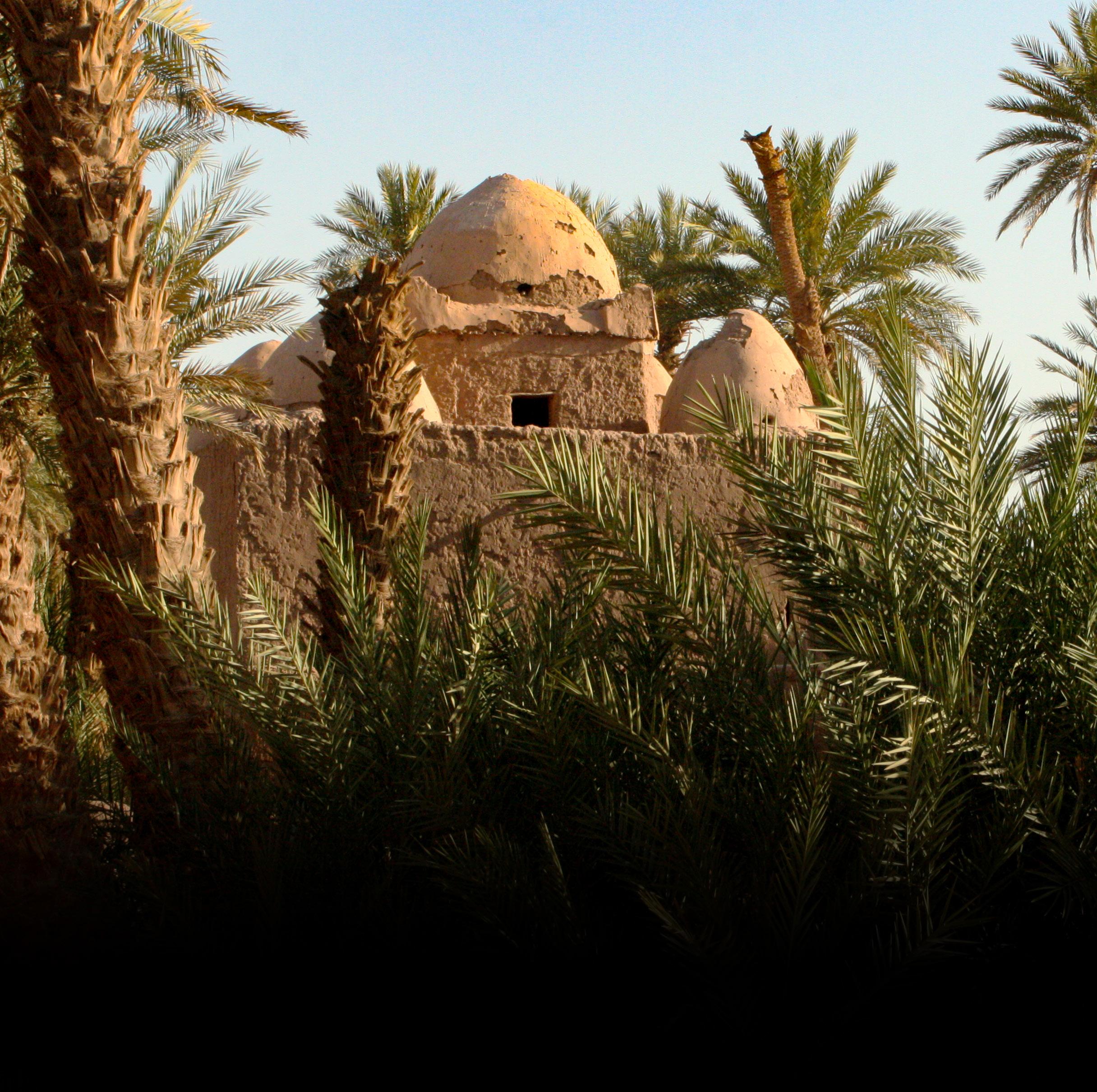
An Old Ksar in the M’Hamid Oasis Ouled Youssef


Ouled Youssef
An Old Ksar in the M’Hamid Oasis
Authors: Marta Colmenares Fernández, Oriol Domínguez Martínez, Alejandro García Hermida, Rebeca Gómez-Gordo, Carmen Moreno Adán, Susana Osés, Raquel Peña López, Giamila Quattrone
Editing: Giamila Quattrone, Claudia Briguglio, Raquel Peña López, Marta Colmenares Fernández, Carmen Moreno Adán
Photographs: ArCHIAM, Terrachidia
Drawings: ArCHIAM, Terrachidia
Watercolours: Amanda Roelle
Design and layout: Serena Liguori
Collaborators: Sara Ferrarotto
English translation: Isaac Sánchez
Arabic translation: Ataa Alsalloum, Kenza Belahnech
Copyright ©ArCHIAM, Terrachidia
Published by: Intbau España
ISBN: 978-84-09-29356-8
Legal deposit: D.L. TO 97-2021
This publication has been produced with the financial support of the Barakat Trust and the University of Liverpool as part of the project Restoring, Recording and Inventorying the Tangible and Intangible Cultural Heritage of the M‘Hamid Oasis, Morocco, 1st January-31st December 2019, led by Dr Giamila Quattrone and carried out by ArCHIAM (Centre for the Study of Architecture and Cultural Heritage of India, Arabia and the Maghreb), University of Liverpool, and Terrachidia.
Project participants included Dr Ataa Alsalloum, Dr Konstantina Georgiadou, Claudia Briguglio and Matina Vrettou (ArCHIAM), Serena Liguori and Sara Ferrarotto (Erasmus+ Trainees at ArCHIAM), Monika Koeck (CineTecture), Marta Colmenares Fernández, Alejandro García Hermida, Carmen Moreno Adán and Raquel Peña López (Terrachidia).
All rights reserved. No part of this publication may be reproduced in a retrieval system, or transmitted in any form or by any means, electronic, mechanical, photocopying, recording or otherwise, without permission of the copyright holders. Project





Partners Financial Support Patronage
This publication gives us the opportunity to showcase the rich heritage, both material and immaterial, of Ksar Ouled Youssef, in the M’Hamid Oasis, in the hope to generate wider awareness of its cultural significance and struggle to survive desertification, sand dunes encroachment and outmigration. It also allows us to show our profound gratitude to the people of the ksar for their unparalleled hospitality, generosity and eagerness to share their traditional knowledge, and make their habitat and way of life known to outsiders like us.
Our sincere thanks go to the local institutions, the Caidat and Commune of M’Hamid, and to Abdelkader Laarija for the constant support provided in the Restoration, Recording and Documentation of Earthen Architectural Heritage Workshop, which lies at the heart of the project.
We are indebted to our interviewees Khalifa Mharzi (facilitator), Bouchaib Bourhim, Lahsan Kuidr and Abdelkader Mahassine (masters), Abdelhak Chakron and Moussa Touhami (apprentices), Kenza Belahnech (workshop participant and interpreter), Latifa Aghlan (resident), the performers Ibrahim Laghfiri (singing and guitar playing), Association for the Revitalization of the Oasis Heritage in M’Hamid El Ghizlane (Rokba music and dance), Koider Abderhamane and Mohammed Benchekroun (chanted poetry), Zahra Benchekroun (resident) for the couscous demonstration, and Amanda Roelle (workshop participant) for the watercolours.
We gratefully acknowledge the financial support of the Barakat Trust and University of Liverpool, as well as the contribution of all workshop participants, without whom this project would not have been possible.
Finally, special thanks go to Roger Mimó for being a source of inspiration and knowledge.
4 | 5


M’Hamid Oasis Landscape, history and society Settlements Oasis Present-day threats and challenges 25 33 41 43 17 Introduction CONTENTS
The


6 | 7 Ksar Ouled Youssef Introduction South gate North gate Houses Marabout Arts and Crafts Introduction Basketry Embroidery Carpet weaving and pottery Music, dance and oral poetry Gastronomy Building crafts Glossary Bibliography 71 73 75 77 79 83 87 93 95 47 51 53 55 61
ArCHIAM
ArCHIAM, Centre for the Study of Architecture and Cultural Heritage of India, Arabia and the Maghreb, is a research platform that, cutting across traditional disciplinary boundaries, aims to further our understanding of how human culture and social practices in these three interconnected global regions are expressed spatially, and how in turn space affects the cultural practices of local groups and communities.
As the populations of the world grow and develop, the quickening pace of progress has become a threat to the legacy of many world’s cultures. The rapid expansion of cities and infrastructure exerts great pressures on the fabric of the past, while changing mentalities, complex notions of modernity and climate change often lead people to abandon their traditional lifestyles and built environments. Globalisation is the greatest contributor to social change and transformation, making the protection of cultural heritage a paramount objective in the retention of a people’s shared cultural identity.
With this in mind, ArCHIAM develops theoretical positions and practice-based research to aid in the preservation of the past and its meaningful transmission to the future. Working in collaboration with government, academic and cultural institutions, as well as NGOs in India, Oman, Qatar and Morocco, the Centre has developed worldleading expertise in the following areas:
Heritage Documentation & Analysis provide the data base necessary for the preservation of the remains of the past. The Centre produces high quality, detailed urban and architectural documentation based on measured sketches and informed by anthropological field data. The Centre uses the latest survey technologies including micro-copter aerial photography and GIS analysis.
Heritage Management & Development ensure a sensitive approach to the preservation and reuse of cultural heritage through effective stakeholder involvement. ArCHIAM’s Heritage Management Plans (HMPs) put forward strategies and methods for the conservation and adaptive re-use of historic settlements in a sustainable and non-disruptive manner, by reintegrating them into the country’s economic life and, thus, making them relevant to local communities.
Heritage Dissemination, Awareness Raising & Capacity Building ensure that the significance and heritage values of sites are made known to, and understood by, the wider public through visualisations, animations and virtual reconstructions to better illustrate past manifestations of sites and their possible future uses. In the process, capacity is also built amongst stakeholders and the general public through hands-on activities.
The Centre consists of researchers in architecture, archaeology, social history, ethnography, conservation and digital documentation. The ArCHIAM Team comprises Prof Soumyen Bandyopadhyay (Director), Dr Giamila Quattrone (Coordinator), Dr Ataa Alsalloum (CoInvestigator), Dr Konstantina Georgiadou and Dr Mary Shepperson (Research Associates), Claudia Briguglio and Matina Vrettou (Research Assistants).
For further information: www.archiam.co.uk




8 | 9
Heritage Documentation
Heritage Capacity Building
Heritage Management
Heritage Awareness Raising
TERRACHIDIA
Terrachidia is a Spanish non-profit NGO established in 2012 by a group of architects who specialise in Heritage Preservation and Development Cooperation, and share an interest in vernacular architecture, traditional crafts and building techniques.
Since its establishment, Terrachidia has found in the M’Hamid Oasis, in southern Morocco, an ideal implementation ground for vernacular heritage preservation and promotion through the Preservation of the Cultural Heritage of the M’Hamid Oasis Project. More recently, the association has been also involved in heritage projects in Mauritania and Spain, with the shared goal of:
• studying, promoting and preserving architectural and cultural heritage as a driver for local development;
• promoting intercultural dialogue, cultural diversity and responsible tourism;
• improving the living conditions of the local communities through infrastructural projects (sanitation) and smallscale business development (women’s crafts cooperative);
• training in traditional building techniques through hands-on workshops;
• raising awareness of traditional architecture and construction as a model for contemporary practice.
Since 2012, Terrachidia has been regularly carrying out restoration and conservation of key communal buildings
in different settlements within the M’Hamid Oasis through hands-on workshops. These offer local apprentices as well as participants from all over the world the unique opportunity to learn-by-doing the traditional building crafts of southern Morocco directly from local masters.
The workshop format allows to allocate a small budget for the purchase of building materials and tools, and a larger amount of the overall budget for the procurement of local labour. This way Terrachidia contributes, through small-scale initiatives, to local development, the preservation and transmission of century-long crafts and associated know-how.
During initial consultations between Terrachidia, community representatives and key local associations a consensus is reached on the site to be restored during the workshop, the masters to be recruited, their respective roles in the restoration work, and the apprentices to be hired. Ahead of the workshop activities, preliminary reconnaissance and documentation of the chosen site are also carried out, accompanied by a tentative inventory of the wider settlement’s heritage alongside any necessary site clearing and debris removal.
Terrachidia’s Board of Directors comprises Carmen Moreno Adán (President), Marta Colmenares Fernández (Secretary), Raquel Peña López (Treasurer), Alejandro García Hermida (Founding Member), Oriol Domínguez Martínez (Founding Member) and Rebeca Gómez-Gordo Villa (Member). Over the years, numerous collaborators have contributed to the implementation of projects, and over 300 participants have taken part in workshops.
For further information: www.terrachidia.es.


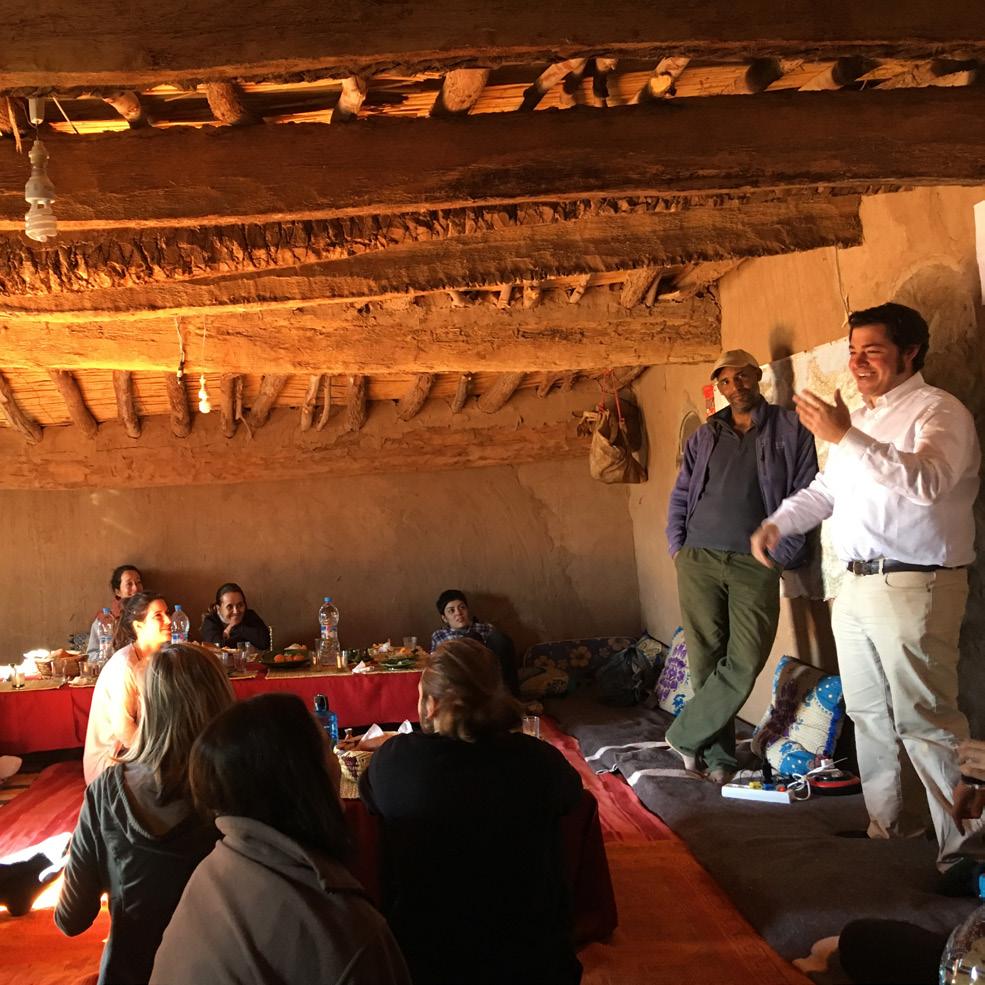

10 | 11
Carmen Moreno Adán and Khalifa Mharzi on site Terrachidia members at a gate under restoration
Alejandro García Hermida giving a workshop talk Terrachidia members receiving the INTBAU Excellence Award
PREFACE
Heritage is a term we use today to encompass many things. In its most fundamental form it includes all aspects of human culture or society that invoke or generate elements of collectively held or shared, real or imagined pasts in the present. In this complex interplay between the pasts and the present, the role of traditional built environments is an important one, as they provide the resilient settings for continued human production and performance. Earthen construction – be it sun-dried mud bricks or rammed earth – has been employed across many parts of the world for over 10,000 years and have produced some of the most versatile and diverse forms of living environments providing shelter and comfort within some of the most challenging climatic conditions. However, these are also some of the most fragile ones that are only maintained through continued inhabitation, care and maintenance.
This present publication on the M’Hamid Oasis in the Draa River Valley of Morocco is an excellent attempt at showcasing just such a complex earthen environment and to introduce the range of arts and crafts the people of this pre-Saharan oasis practice. The significance of this publication also lies in the story of how small steps are being taken towards the restoration of this oasis and its intangible heritage. The need for collaboration between governmental, non-governmental and academic entities is essential to create the ideal balance
of intention, expertise and implementation possibilities. The coming together of the Spanish NGO, Terrachidia, and the University of Liverpool based research centre, Architecture and Cultural Heritage in India, Arabia and the Maghreb, ArCHIAM, has ensured a deep engagement with understanding the built tradition and establishing the ways of its restitution, where needed.
Terrachidia’s initiative to hold annual international earthen heritage training events, later joined by ArCHIAM, has made an important difference to the community and the visibility of its traditions and practices. This unique collaboration has also ensured that one of the constituent settlements of the oasis, Ksar Ouled Youssef, is comprehensively documented and many of the arts and crafts practices related to everyday life recorded. The building crafts practices have understandably received focused attention, which demonstrates the knowledge that has been generated by this collaboration. One would hope that such initiatives are undertaken more frequently and across the many significant sites of earthen construction to harness the traditional knowledge for its employment in a sustainable future.
Professor Soumyen Bandyopadhyay
ArCHIAM Director and Sir James Stirling Chair in Architecture, Liverpool School of Architecture

12 | 13
Introduction

This publication aims to showcase the historical, geographical and cultural significance of the M’Hamid Oasis and its rich tangible and intangible heritage, which risks disappearing under the threat of fast-paced sociocultural change, desertification and myopic planning strategies. It also aims to create wider awareness of the struggle for survival of this place and highlight its untapped tourism potential.
The book introduces the reader to M’Hamid, a living example of traditional pre-Saharan oasis habitation, through a short historical and geographical account. The urban and architectural morphology of its fortified earthen settlements (ksar, pl. ksour in Arabic; ighrem, pl. igherman in Berber) are presented, followed by a short description of dwellings, communal buildings and other civic facilities. Finally, the oasis, a millennia-old anthropic system capable of sustaining life in the desert, is described with respect to its natural and man-made components.
Following the overview of the M’Hamid Oasis, the book focuses on Ksar Ouled Youssef, one of its eleven ksour, situated to the north of the southern branch of the Draa River. Ouled Youssef is the site of the Restoration, Recording and Documentation of Earthen Architectural Heritage Workshop, which, from 10th to 18th February 2019, brought together 20 participants from Spain, Italy, Turkey, Bulgaria, USA, Colombia and Morocco, including professionals, students and graduates from

Ksar Ouled Youssef
Introduction

16 | 17
very diverse backgrounds. Under the supervision of local master builders (maalem), and with the help of young apprentices, participants restored the nearby marabout, the burial place of Sidi Abdellah Khalifa, a man held in great respect by the local community. The mausoleum, which lay in a state of advanced dilapidation, was restored employing local materials and traditional southMoroccan techniques.
Participants were trained in urban and architectural documentation techniques (photography, sketching, tape and laser measuring) by the ArCHIAM team, and in earthen building techniques (mud bricks, mud renders, rammed earth, tadelakt) by the master builders, under the coordination of the Terrachidia team.
Alongside recording and restoration, workshop activities included arts and crafts demonstrations, dance, music and chanted poetry performances that were documented by film-maker Monika Koeck in M’Hamid Oasis, Morocco. Since its screening at the XIII Istanbul International Architecture and Urban Films Festival on 13th November 2019, this short documentary film, accessible at www.vimeo.com/338001258, has racked up a number of official selections (2021: Kalakari Film Festival, Golden Bridge Istanbul Short Film Festival, Master of Art Film Festival; 2020: Rome Prisma Independent Film Awards, The Archaeology Channel International Film Festival; 2019: ARFF Berlin, Dumbo Film Festival), has received Honorable Mention as 2020 Best Short Documentary at ARRF Berlin, and scored semi-finalist spots at the New York Cinematography Awards.

Introduction
Master builder and assistant rebuilding a rammed earth wall



18 | 19
Mud bricks making and rammed earth wall construction Tamping of the mud and straw mix into a wooden brick mould
Restoration works of the Sidi Abdellah Khalifa Marabout in Ouled Youssef

Introduction

20 | 21
The M’Hamid Oasis

LANDSCAPE, HISTORY AND SOCIETY
In the arid pre-Saharan plains of south Morocco, through which the river Draa runs, a string of small havens of greenery and life dot the otherwise barren desert landscape. Oases were historically important as rest stops for caravans travelling through the Sahara. Today, their palm trees stand partially buried under the sand in front of the advancing desert dunes.
M’Hamid is the last and southernmost oasis of the Draa Valley. Shortly past it, the river seeps into the ground, where it continues its journey towards the Atlantic Ocean. The majority of the region’s sedentary population nowadays lives in the oases and very few nomads still inhabit the desert. Using their intelligence and skills, those in the past who ventured into the harsh desert landscape were able to build, over the course of centuries, a complex irrigation system made of channels and wells, which breathed life into the region. They allowed dense groves of date palm trees to thrive, under whose shade wheat, legumes, vegetables and fodder for animals could be cultivated.
The economic wealth generated by oasis agriculture needed to be defended from the attacks of nomadic tribes that controlled the territory. Hence, the need to erect high curtain walls around the settlements, with the added advantage of protecting the inhabitants from the adverse climate. M’Hamid’s remoteness and proximity to the great expanse of the Sahara desert made it impossible for nomadic tribes to exert a strong and stable political
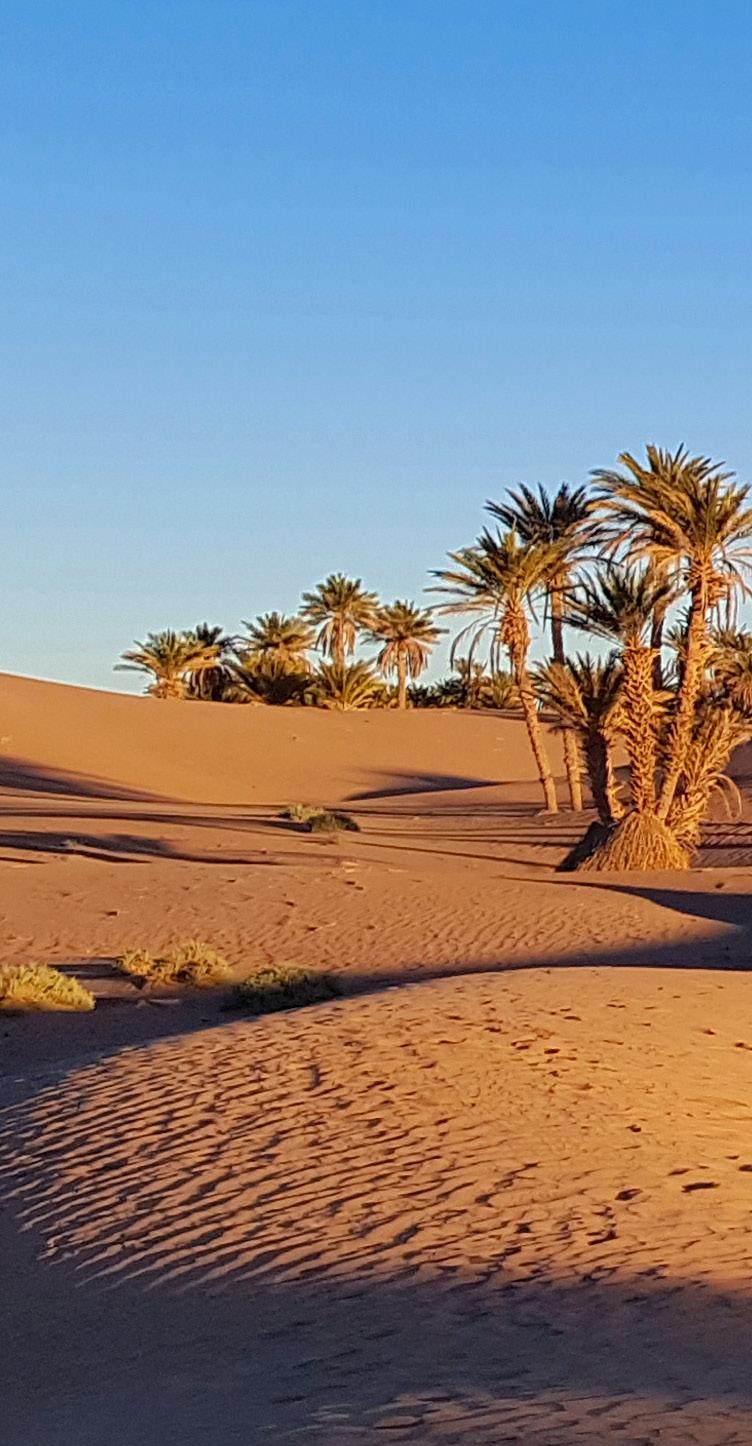
The M’Hamid Oasis
Palm trees encroached upon by the sand dunes in the M’Hamid Oasis
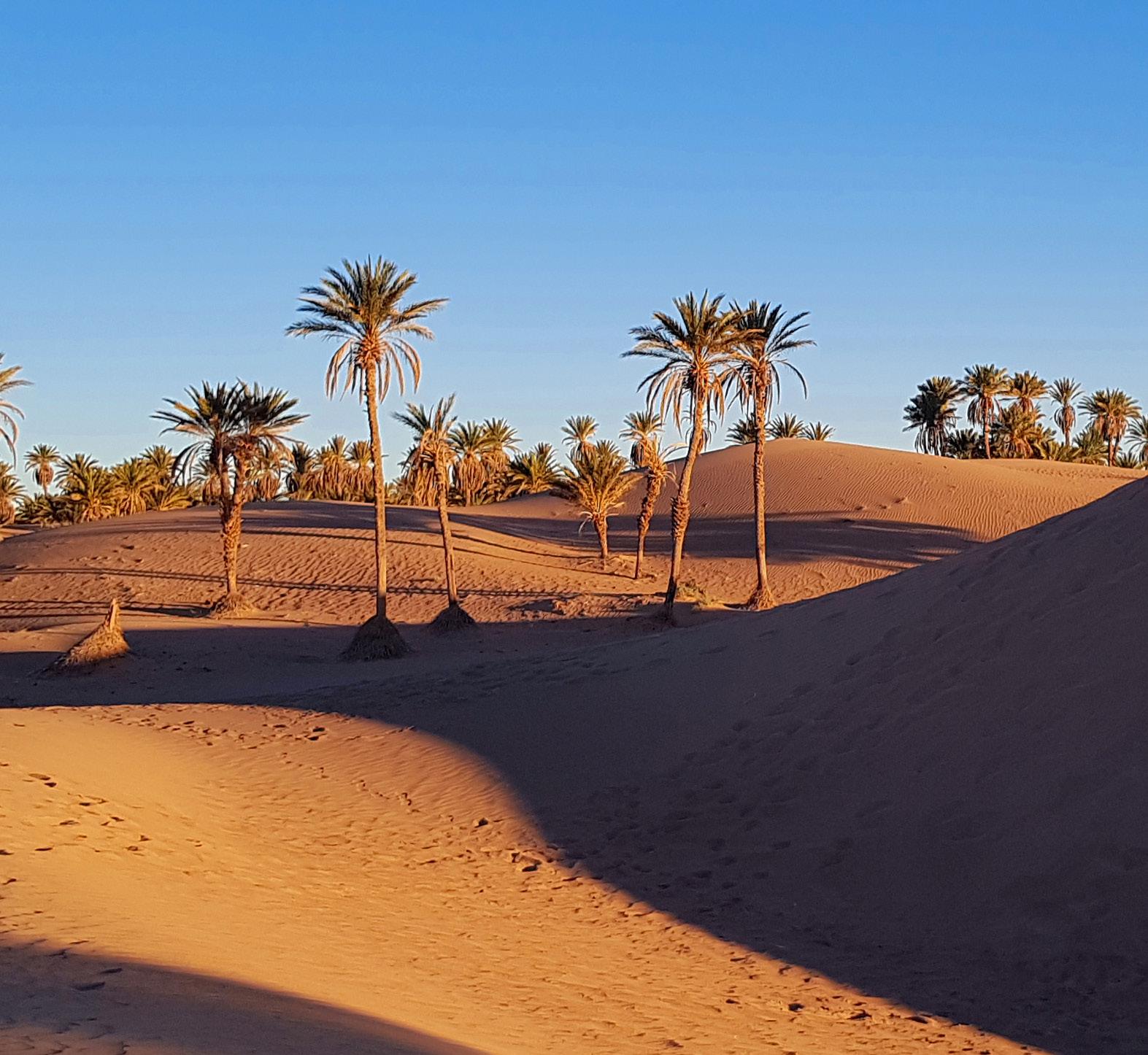
24 | 25
control over the area. Nevertheless, interest in subduing the region never ceased. Besides the rich agricultural production, in particular the export of dates, the control over the area provided also access to one of the major trade routes that connected Sub-Saharan Africa with the Mediterranean Sea, long before advances in navigation made it possible to travel through less dangerous routes. This strategic caravan route descended, through the Draa Valley, to the doorstep of the desert, the M’Hamid Oasis. Here, caravans stocked up supplies before setting out on a long journey through the desert to their place of destination, then known as Sudan. This was rich in gold, ivory and other valuable goods, which were transported from the major economic and cultural centres, which flourished thanks to this trade, to the coast of northern Africa and southern Europe. The most renowned of these prosperous cities was the legendary Timbuktu. The close relationship between both sides of the desert left a significant cultural imprint on this area. Unfortunately, in recent decades these routes have been disrupted by ethnically and politically charged conflicts, and are currently closed.
On the other hand, the landscape of the area was different. Before date palm trees were imported from the Middle East, oases did not exist as we know them today. In the past, these plains were savannah partly covered with grass, while a big lake extended beyond the M’Hamid Oasis. The former capital, M’Hamid El Ghizlane, was named after the many gazelles that roamed the surroundings. Today, they can only be occasionally spotted.
Both the Drawa — as the original inhabitants of the Draa Valley are known — and the Berber population likely originated from communities that arrived here

The M’Hamid Oasis
Desert dunes advancing towards the palm trees
from the upper river and the edges of the desert. The Drawa, dark-skinned, were undoubtedly the first to arrive here, from the south. The Berbers (or ‘Imazighen’ as they refer to themselves in their own language, which is called ‘Tamazight’), fair-skinned, came from the north and east, possibly later, but imposed their culture to the former. However, some Drawa were later assimilated into the Arab culture. Jewish settlers arrived in the region as a result of the diaspora, as did Christianity, before the arrival of Islam in Morocco in the 8th century. It was not until then that historical references to the Draa region began to increase. The area became dominated by the Emirate of Sijilmasa, the first Moroccan emirate, the capital of which was the neighbouring town of Tafilalat. This kingdom would later be confronted with the Idrisid dynasty established in Fez. The region played a key role in the control of the Saharan trade routes during
the clashes between the Caliphates of Córdoba and Kairouan. Desertification of the territory was by now complete, and therefore the caravans of dromedaries had become crucial in ensuring access to the gold and slaves from Sudan.
In the 11th century, a group of Berber warrior-monks of the Sanhaja ethnic group arrived here from what is now known as Mauritania. They were the Almoravids. After conquering the Kingdom of Sijilmasa and gaining control over the Saharan trade, they launched attacks both north, against the Kingdom of Fez and the Taifa Kingdoms, in which Al-Andalus — the Muslim kingdom then occupying much of the Iberian Peninsula — was divided, and south, against the Kingdom of Ghana.
In the 12th century, the Almoravids were defeated by a new Berber dynasty, the Almohads, who stayed in power

26 | 27
Palm tree groves in the M’Hamid Oasis
for a century. After their fall, anarchy reigned in the region for a long period of time.
Arab and Berber nomadic tribes began invading the area in successive waves, seeking control of the trade routes and the subjugation of the sedentary populations that farmed the oases. Since the 13th century, the continuous arrivals of new tribes in the region caused the progressive cultural Arabisation of the early inhabitants, the Drawa in particular. Some of the new settlers, such as the Chorfa, considered to be descendants of the Prophet Muhammad, enjoyed a privileged position. Instability and insecurity caused the collapse of trade and, thus, started a period of general decadence. The situation worsened with the opening of new maritime routes to the south by the Portuguese, who dominated the Moroccan coast, and with the exploitation of American gold by the Castilians.
The power vacuum was partly filled by religious brotherhoods (zawiyas), some of which took control over vast areas. In the 16th century, a family of marabouts from the Zawiya of Tagmadert, in the Draa Valley, managed to temporarily re-establish the order in the southern valleys. Soon they occupied the rest of the country, establishing a new Saadi dynasty in Marrakech and achieving important victories over the Portuguese. Under the rule of King Ahmed El Mansur and with the support of an Andalusi army, which had escaped from Spain after the fall of Granada, the Saadis took back control of the caravan routes, and managed to conquer Gao and Timbuktu. A testament to that period of the history of the M’Hamid Oasis is El Aluj, an ancient fortress founded by El Mansur, used as a bridgehead during the conquest.
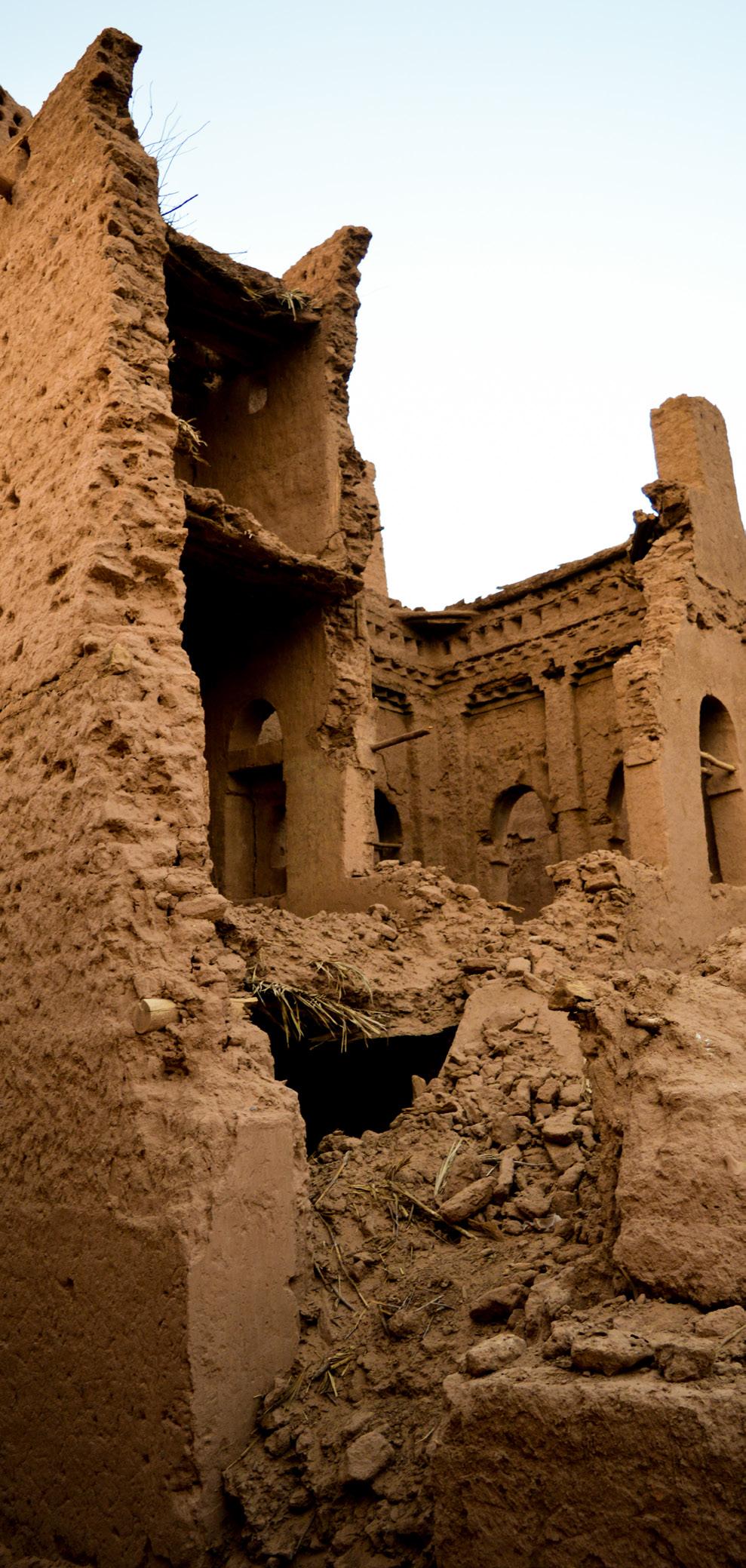
The prosperity that the Saharan trade brought to the oasis is reflected in the settlement of a prominent Building ruins in Ksar Bounou
The M’Hamid Oasis
Jewish community in M’Hamid El Ghizlane. In its main street used to be held the most important market in the oasis. Various houses of particularly high constructional quality attest the Jewish presence in the ksar, while, unfortunately, the ancient synagogue has gone.
However, peacetime was not long-lasting and, once again, the southern valleys were threatened by political instability and tribal warfare. This continued for a long time, until the region fell under the control of another family of Chorfa Alaouites from Sijilmasa. In the late 17th century, Sultan Mulay Ismail was able to subdue the rebel tribes of the region, after besieging M’Hamid El Ghizlane for a long period of time. After the revolt was suppressed, the city walls were demolished.
Nevertheless, the Sultan’s efforts turned out to be in vain after he died, giving way to one of the most violent
periods in local history. The inhabitants of the ksour, preyed on by various tribes of nomadic warriors, Arabs and Berbers alike, were forced to pay tributes to some tribes in return for protection against the others. Various communities were forced to move into the new fortified villages or to form groups with other tribes in order to better protect themselves. In the 19th century, several Berber tribes migrated from the Atlas to the south. The large Berber confederations, Ait Atta and Ait Iafelma, competed with each other for control over the southern oases. At some point during this fight, the M’Hamid Oasis was subjugated by the Ait Atta, who settled down in Ksar Rgabi, expelling the resident Drawa population and forcing it to move to what is now known as Qabo.
In later years, the sultans of Fez sought support from the increasingly powerful chieftains (qaids) to take back

28 | 29
Houses in Ksar Ouled Mhia swallowed by the sand dunes
control over the South. One of the most prominent ones were the Glaoui, who were originally based in Telouet, from where they dominated the Atlas crossing to Marrakech. The first French and Spanish incursions began around 1890. The French conquered Timbuktu in 1893, which represented a fatal blow to those who controlled the trade routes in the region. Soon the Glaoui offered their services to the new rulers, who funded them to subjugate the population of the southern valleys. Only the Berber confederations challenged the new power, in particular the Ait Atta, who fought French domination until they were finally defeated in the mid-1930s. After the conquest, a French detachment settled in the M’Hamid Oasis, where they built a small colony that later became known as the New M’Hamid. Here, the first qaidat, the government’s local delegation’s headquarters, was established.
Since the beginning of the 20th century, the tribal distribution within the ksour has remain unchanged. However, both serfdom rights between tribes and slavery were abolished. All people began to be considered equal before the law and, over time, former inequalities and strict hierarchies weakened. What remains now is a certain distrust between different factions of the oasis and strong family structures, still significant in the ksour The Glawa’s authority over the region continued to strengthen until 1955, when the Alaouites took back the power they had lost (although they had kept the throne) and the country became independent from France.
As a consequence of this turbulent history, which is both a reflection and cause of numerous political changes in the western Mediterranean, the M’Hamid Oasis is inhabited today by Drawa, Berbers, Arabs, descendants of sub-Saharan slaves and small groups of Sahrawis. On
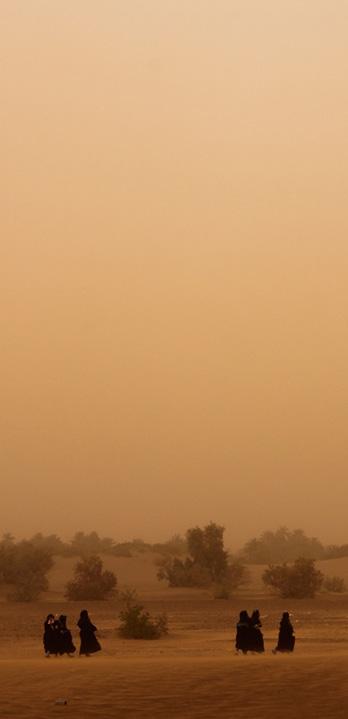
The M’Hamid Oasis
Women crossing the desert during a sand storm
the other hand, most of the Jewish population fled the region during the 1950s and 1960s, settling in Israel. The way in which today the different tribes are distributed across the ksour and the various ethnic groups co-exist is a result and reflection of their belligerent past.


30 | 31
Everyday life scenes in Ksar Ouled Driss
Local master builder
SETTLEMENTS
The population of the M’Hamid Oasis is concentrated in the traditional fortified settlements (ksour) that, surrounded by palm tree groves, dot the plains between, and to the south of, the river Draa’s two branches. Historically, ksour are inhabited by families of the same tribe or different tribes able to live amicably together. There are eleven traditional villages in the M’Hamid Oasis — M’Hamid El Ghizlane, Ouled Youssef, Zaouia El Henna, Ouled Mhia, Znaga, Ait Aissa Ou Brahim, Talha, Chourfa, Bonou, Rgabi and Ouled Driss — and a new grid-planned town, New M’Hamid, which is the focus of commercial activity.
Ksour are compactly built out of earth, the most abundant material locally, palm and tamarisk wood, a native tree to this area. The urban layout displays a fishbonelike organization reminiscent of the Roman castrum. A main street, open to the sky, crosses the settlement longitudinally connecting the two entrance gates located at each end, while narrow, partially covered, alleys branch off the main thoroughfare allowing movement within the settlement and access to the houses crosswise. Each alley belongs to a tribe or family and develops as these grow. Houses turn their back to the surrounding fields, forming a seamless, impenetrable curtain wall that in the past, together with tapering corner towers, defended the population from the attacks of nomadic tribes. While the narrow winding alleys offer excellent protection against wind, dust and sandstorms, the overhead rooms that extend over the main street afford shade.

Street in Ksar Ouled Driss
The M’Hamid Oasis
GATES AND OPEN SPACES
Access to the ksour happens via fortified gates, which are not simply apertures in the perimeter wall but architecturally and spatially articulated structures bustling with life. Originally, they had two doors, one in the perimeter wall and one within the settlement, perpendicular to the former. This 90-degree layout generates a buffer space that, by forcing a zigzag line of approach, afforded defence and concealed the settlement’s interior. Traders, foreigners and travellers were allowed to stay here overnight, protected behind the walls but separated from the residential areas. Large communal open spaces situated immediately past the gate were used as markets (suq) where the caravan trade took place. The size of such spaces indicated the importance of the ksar’s commercial role.


32 | 33
Digital reconstruction of Ksar Ouled Driss
Main gate of Ksar Ouled Driss

The M’Hamid Oasis

34 | 35 1000m 0 500m 200m
HOUSES
The traditional house of the ksour, called dar in Arabic and tiguemmi in Berber, is the space where families dwell and carry out their domestic activities. Houses are simple, two-storey flat-roofed buildings arranged around a high and narrow courtyard (wust-ed-dar), onto which all rooms open. The courtyard functions as a ventilation stack, pushing hot air up and letting cool air in from the street. The continuous natural air movement ensured by the courtyard, along with the thermal inertia of the thick rammed earth masonry walls, creates exceptionally comfortable interiors.
Houses are typically inward-looking and do not have windows facing the street; if they do, these are small in order to help keep the interiors cool throughout the day. This means that the courtyard walls represent the only ‘façade’ of the house. Besides being regularly pierced by openings in the upper sections, the courtyard walls also boast decorative geometric motifs obtained with mud bricks that, by alternatingly jutting out and receding, create unique textures and plays of light and shadow.
The use of the rooms varies depending on the needs of the family or time of the year. There is virtually no furniture in the houses except for a small dining table, other pieces on which people place the TV or store crockery, and rugs on the floor. In the past, domestic animals were kept on the ground floor, while today they are lodged in small abandoned buildings converted into pens. During the summer, life takes place on the ground floor and, at night, the family sleeps on the roof, which is cooler. In winter, the use pattern is reversed. Rooftops are also used by women to sun-dry vegetables and fruit, hang the laundry, and meet with family, friends and neighbours.

The M’Hamid Oasis
Houses’ rooftops in Ksar Ouled Youssef
Recent years have witnessed a proliferation of houses outside the ksour, across the palm tree groves and gardens. Generally, these are new houses built according to the traditional techniques, typically inhabited by families that live entirely on farming.
In the new towns of the M’Hamid Oasis, such as New M’Hamid, where people forced to abandon their home villages moved after the 1990s urban development
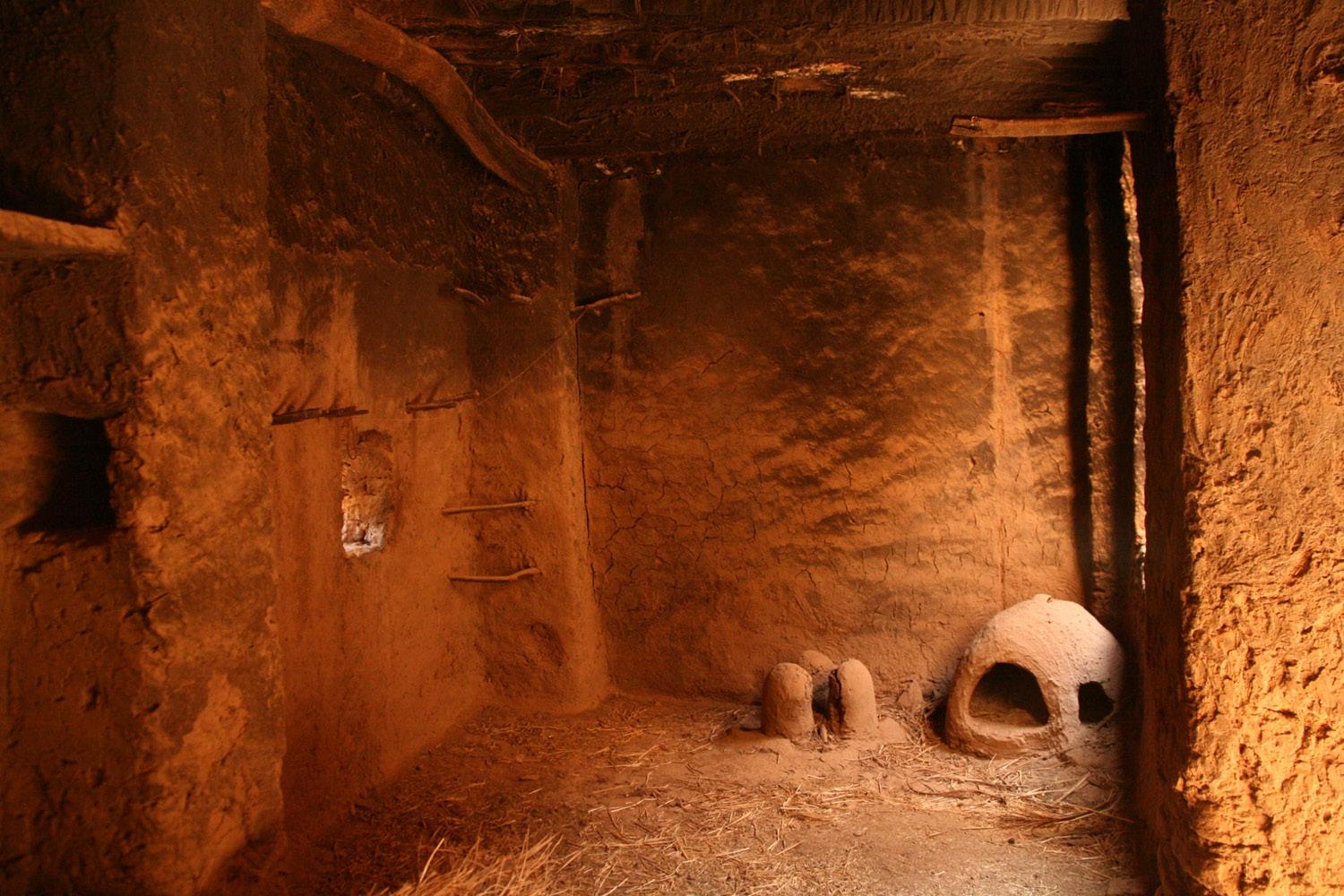

36 | 37
Kitchen with earth cooking pit and oven in Ksar Ouled Youssef
MOSQUES
Mosques are the most significant public buildings in the ksour. Normally, they overlook the open space next to the gates, since travellers and foreigners were granted access to pray, but were not allowed into the village. Like houses and gates, mosques have thick, almost impenetrable, rammed earth walls, while their roofs are flat and built out of timber, with the exception of domes, which are built in mud bricks.
Mosques, generally on one floor, comprise different spaces with specialised uses. They do not feature a minaret, therefore the calls to prayer were traditionally done on the rooftop. The prayer hall is the core and key space of the mosque. Worshippers pray facing the qibla wall, on the eastern side of the mosque, which indicates the direction of Mecca. The wall contains the prayer niche (mihrab), which often slightly projects outwards becoming visible from the outside, and the pulpit (minbar). Opposite the mihrab is usually a small domed space that, in addition to letting sunlight in, enhances and embellishes the space beneath. All mosques feature baths (hammam) where believers perform the ritual ablutions before the prayer. The baths consist of a well, a chamber where the water is heated on a fire and a separate room for the ablutions. When present, the upper floor used to accommodate religious schools, which no longer exist.
One of the largest, oldest and most elaborate mosques of the oasis is that of M’Hamid El Ghizlane, which was also a place where people gathered and shared their knowledge. Its square floor plan, with an area of 640 m2, is divided in two spaces: an entirely whitewashed prayer hall with seven naves on round columns and a central open-to-sky courtyard, and the baths.

The M’Hamid Oasis
Interior of M’Hamid El Ghizlane’s mosque
KASBAS
Southern Moroccan oases are dotted by fortified castles (kasba in Arabic, tighremt in Berber) that were built by a powerful figure or authority, such as a qaid, to afford protection to their inhabitants against the assaults of nomads, who, in some cases, managed to take possession of them. Kasbas are Berber in architecture and construction terms, preferring simple cuboid masses that lack elaborate ornamentation. They generally have a square plan and flat roofs, and a square or rectangular tower at each corner that tapers towards the top. They are typically two or three storeys high, made of rammed earth at the lower levels and mud bricks at the upper ones. In the Draa Valley kasbas are arranged around a courtyard. A significant kasba of the M’Hamid Oasis is that of Ksar Ouled Mhia.


38 | 39
Kasba outside Ksar Ouled Youssef
OASIS
An oasis, as it is commonly understood, is a fertile vegetated area within a desert or semi-desert environment with hyper-arid or arid climate characteristics, and what differentiates it from its surroundings is the presence of water. An oasis is an anthropic ecosystem developed by humans to make habitation possible in such hostile environments.
From an agro-ecological point of view the oasis is structured on three levels: 1) on the ground level are grown vegetables, fodder, aromatic and medicinal plants, 2) on the second level are fruit trees, and 3) on the third level are date palm trees. These are not indigenous but were introduced from the East centuries ago. Palm trees play a crucial role within the oasis ecosystem since, thanks to the shade they create, they provide the right microclimatic conditions for other crops to thrive underneath, and reduce wind erosion and water evaporation.
The gardens of the M’Hamid Oasis are punctuated by traditional wells, which signal that groundwater is available and can be drawn for irrigation purposes. However, in recent decades most wells have been disused and replaced by electrical or diesel pumps. Traditional wells, or balance beam wells (shaduf), are found in areas where the water table lies close to the surface — at a depth of few metres — and can be easily drawn. A counterbalanced beam allows a bucket to be dipped into the well, lifted and emptied into a distribution channel. This forms part of a complex irrigation system (seguia)

The M’Hamid Oasis
Well in Ksar Talha
comprising small dams, bridges, dikes and channels. The well consists of one or two shafts with two or three buttresses up to five metres high. These are made of mud bricks and joined together by tamarisk sticks. The bucket was traditionally tied to one end of a long wooden pole resting on the sticks, which was used as a lever. A weight was placed on the opposite end of the pole, helping lift the bucket full of water with little effort. The well is internally lined in stone masonry made of pebbles from the Draa riverbed, set in lime mortar.
Working in synergy with its fortified settlements, the M’Hamid Oasis has historically provided, on the fringes of one of the most inhospitable deserts, sedentary livelihoods centred on agriculture and animal farming, and complemented by trade.

40 | 41
Vegetable gardens outside Ksar Ouled Youssed
PRESENT-DAY THREATS AND CHALLENGES
The Draa River is the only perennial river to flow into the Sahara from the north. However, since the construction of the Mansour Eddahbi Dam in 1972, upstream of the Middle Draa Valley, it has become seasonal, carrying water to M’Hamid only occasionally throughout the year.
The siltation to which the dam is subject has drastically reduced its capacity. At the same time, the number of motor pumps extracting groundwater for agricultural purposes has increased steadily. Both phenomena, coupled with repeated severe drought and the shift to more profitable, yet water-demanding, crops such as watermelons have caused the progressive depletion of the water table. Moreover, an increase in groundwater salinity is also recorded.
Mismanagement and overexploitation of water resources, overgrazing and climate change accelerate desertification, which in turn causes loss of soil fertility, affects crop yield, threatens food security, and leads to economic loss. Additionally, farmland has significantly lost ground to the advancing sand dunes, particularly in the southern part of the oasis where Ksar Bounou and Ksar Ouled Mhia lie in a critical situation.
The water shortage makes it impossible to support the farming-centred local economy. In this context of struggle for survival, those who decide to stay in the oasis are being forced into tourism. This is a steadily growing

The M’Hamid Oasis
Cracked soil caused by drought
industry given the proximity to the great expanse of Erg Chegaga, which is reached starting from M’Hamid El Ghizlane and travelling along an old caravan route. Others are, instead, forced to migrate to the big cities of Morocco or overseas in search for employment and better life opportunities generally.
Abandonment accelerates the dilapidation of settlements, producing as much the loss of traditional built fabric as of traditional agricultural and animal husbandry practices, building techniques, arts and crafts. These are all expressions of a way of living that is deeply embedded in the oasis habitat and that makes use of its readily available resources. Away from the oasis its intangible heritage is at risk.


42 | 43
Ksar Bonou partially buried under the desert sand
Ksar Ouled Youssef
Ksar Ouled Youssef

INTRODUCTION
Ksar
Ouled Youssef is located to the northeast of M’Hamid El Ghizlane. The two ksour allegedly stem from the same settlement, which later grew and evolved into two distinct villages.
The settlement is a compact agglomeration of courtyard houses on two and three storeys, densely built one next to the other. Its main street runs north-south and connects the two entrance gates. The south gate was restored in 2013 during one of Terrachidia workshops, and still retains the typical elbow-shaped layout. The north gate currently lies in advanced state of dilapidation. Secondfloor rooms straddle both the main and secondary streets, which run crosswise east-west providing pockets of shade at regular intervals along the sun-scorched routes.
Large open spaces, which are accessed via straight secondary streets, are found in the southern section of the settlement. One of them is located around the old mosque, at the south-east corner of the ksar, the other around a neighbourhood of private dwellings, close to the south-west corner.
Regrettably, the old mosque located by the south gate was demolished at the end of 2019 and replaced by a modern concrete mosque. It was a small and simple trabeated structure built entirely in rammed earth and internally whitewashed. One-third of its square floor plan was taken up by the women’s mosque and an additional
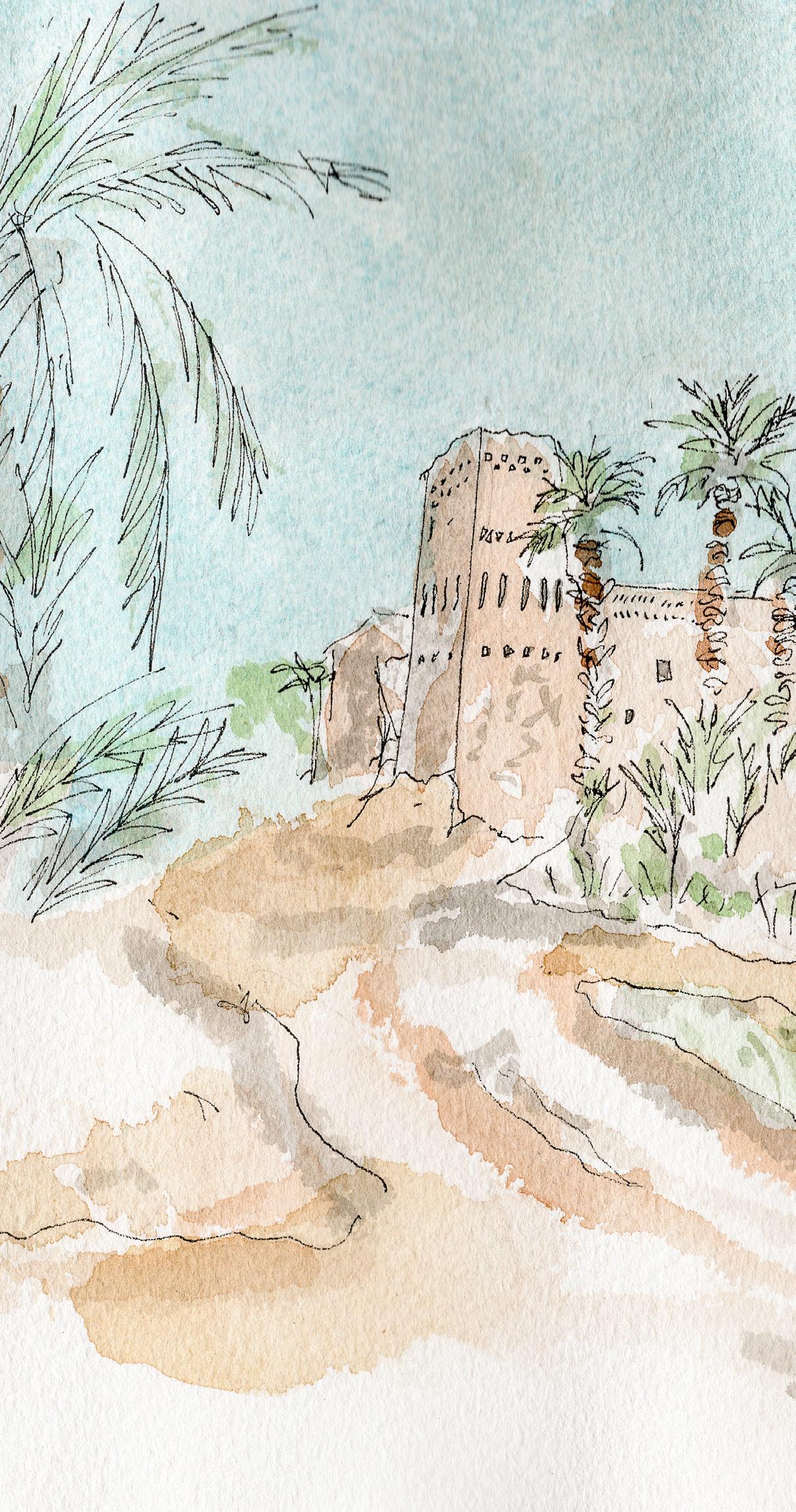
Ksar Ouled Youssef

46 | 47
chamber. The prayer hall consisted of four naves on six columns, which ran parallel to the qibla wall. At the centre of this was a mihrab with a small decoration of angled bricks. The entire roof structure of the hall was made of tamarisk and palm tree branches, with the exception of the mihrab. This was roofed by a beautiful octagonal dome built out of mud bricks and palm tree trunks, whose whitewashed surface could be partially seen from the outside. The baths were located in the southern area of the building, which protruded out of the settlement’s perimeter wall. They consisted of a square room where the water was heated, and an elongated space subdivided into cubicles where ritual ablutions took place.
Located north-west of the settlement, amid the palm tree groves and within close proximity to both M’Hamid El Ghizlane and Ouled Youssef, is the Marabout of Sidi Abdellah Khalifa, another architectural jewel of the M’Hamid Oasis.

Ksar Ouled Youssef
Plan of Ksar Ouled Youssef based on the survey carried out in 2014 and 2019 0 2m 5m 10m

48 | 49
SOUTH GATE
The south gate is located west of the mosque. Though it is somewhat smaller than most gates in the oasis, it displays the same harmonious proportions and similar decorative patterns. Its elbow-shaped plan responds to the need to reduce the visibility of the main street to outsiders and ensure the privacy of residents. The gate is built in mud bricks. Its outer façade is decorated with small square and slit-like ventilation openings, while stepped finials rise above the wall’s top edge at the corners and in the middle.



Ksar Ouled Youssef
Interior of the south gate looking towards the settlement
Exterior façade of the south gate before restoration
Exterior façade of the south gate after restoration

50 | 51 Plan of the south gate 0 1m 2m 5m
NORTH GATE
The north gate gives access to the settlement from the gardens and marabout. It is too built out of mud brick masonry plastered in mud. The gate sits on the ksar’s perimeter wall marking the north end of the main street. A few metres away, this turns into a covered passage that eventually leads into a communal open space. The covered passage is structured in seven bays with pillars sticking out of the side walls, linked by cross beams. These support a ceiling made of tamarisk and palm tree branches laid perpendicularly to the beams.



Ksar Ouled Youssef
Covered passage of the north gate
Interior façade of the north gate
Exterior façade of the north gate

52 | 53
of the north gate 0 2m 5m 10m
Plan
HOUSES
The houses of Ksar Ouled Youssef follow the typical courtyard-type plan organization of domestic buildings in the M’Hamid Oasis. Houses are generally on two storeys connected via steep and dark U-shaped staircases. Located in a corner, either opposite or to the side of the entrance, the stairwell is delimited by external walls on two sides and partition walls on the other two. The understair space is used as storage.
The ground floor rooms are arranged around the courtyard and accessed from the columned gallery around it. Both courtyard and gallery are top-lit and used for food preparation and cooking this usually happens in a corner of the gallery on earth cooking pits and ovens (coucha) — and food consumption. Being the external walls of the houses nearly windowless, the rooms on the perimeter are completely dark, therefore used mainly for storage. The first floor accommodates the living and sleeping quarters, and at times cooking pits as well as a reception space.
The courtyard represents the heart of the house, not just because of its central location but because it is here that women’s domestic activities take place, from daily chores to craft making. The space is marked by L-shaped corner pillars that rise to the rooftop and create trabeated openings on the ground floor. Within these are pairs of timber logs fixed to the pillars, used to rest or hang household items such as baskets, pots and pans. On the upper floor, the mud brick walls between
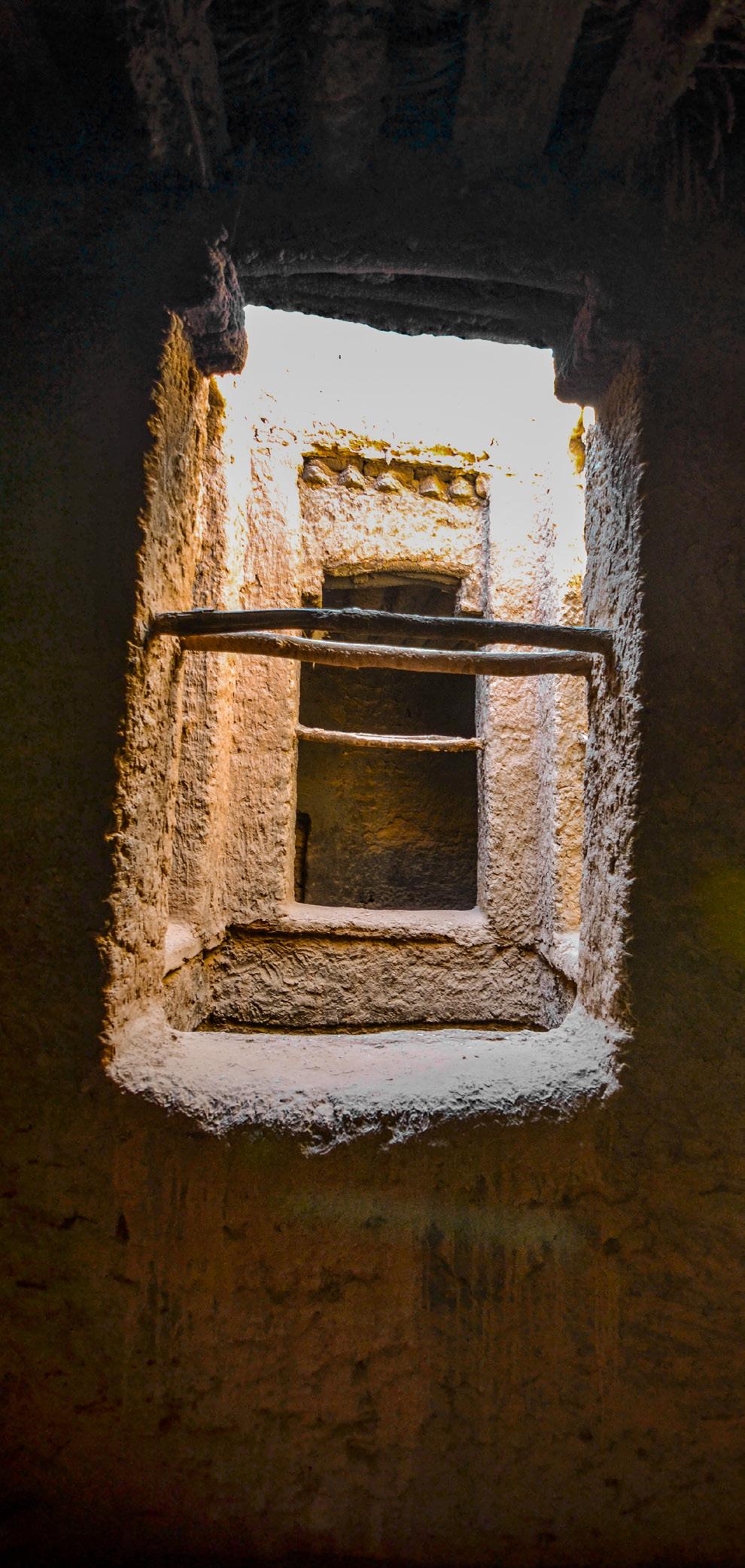
Ksar Ouled Youssef
Wall opening overlooking the courtyard of house D3
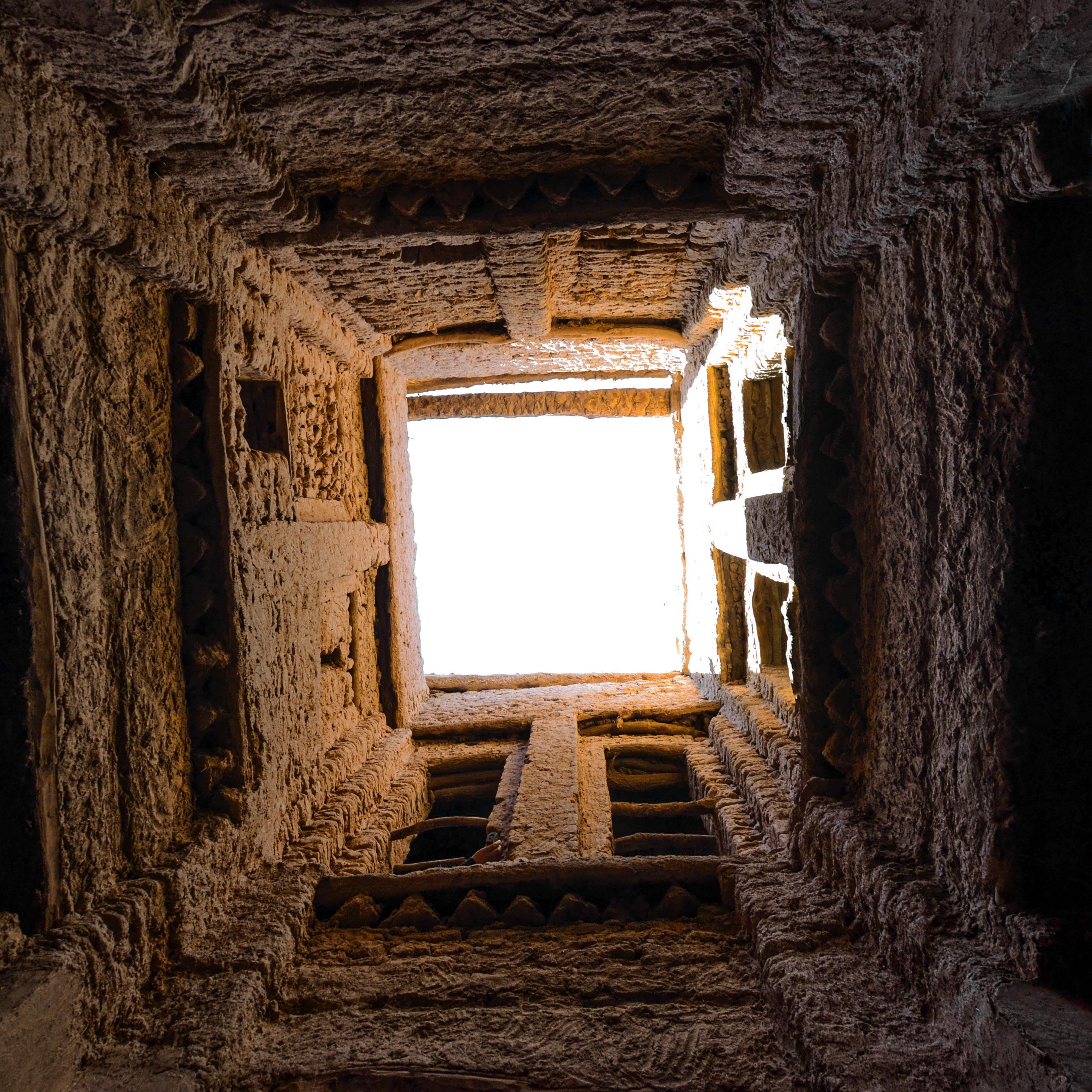
54 | 55
Bottom-up view of the courtyard of house D3
the pillars taper out towards the top creating, at floor level, ledges reinforced by timber logs and decorated through rows of bricks laid at an angle. Courtyard walls are articulated into two symmetrical recesses, each containing a rectangular opening strengthened by a pair of timber log ties. The play of solids and voids, recesses, protruding bricks and L-shaped pillars, combined with coarsely-plastered wall surfaces that amplify the textural effect of light and shadow, makes the courtyard a distinct architectural space, standing in stark contrast with the plainness of all other rooms.
D3, one of the three houses documented in Ksar Ouled Youssef, results from the organic growth of a standard house into a double unit with independent yet communicating courtyards, in order to accommodate the needs of a growing household.

Long section of house D3
Ksar Ouled Youssef

56 | 57 Ground floor plan of house D3 0 1m 2m 5m

Ksar Ouled Youssef

58 | 59
MARABOUT
The word marabout, commonly used in North and West Africa, designates a ‘holy man’, a distinguished person with a special bond with God, held in high respect by local communities. This often identifies with a Sufi Muslim teacher heading a religious school (zawiya). The religious prestige of marabouts historically carried political influence, which was evidenced by their not unusual role as ‘justices of the peace’ and mediators in conflict resolution between neighbours.
The word also indicates the funerary building erected to pay respect to a marabout. Since believers credit these holy men with various virtues and miraculous gifts, their mausoleums are places of pilgrimage, visited to pay them homage as well as ask for their intercession for common ailment
The building type is common across Maghreb and, in Morocco, in the Draa Valley. Marabouts are small compact buildings, located in close proximity to settlements. They contain the tomb of a marabout, often of some of his relatives. Marabouts are built out of rammed earth and typically have a small dome on the top. This is made of mud bricks laid according to the corbelling technique, that is on top of each other with successive layers being slightly offset. The result is an architectural device of simple beauty, which imparts the space below a sense of gracefulness. Both the interior and exterior surfaces of the dome are whitewashed.

Ksar Ouled Youssef
Interior of the Marabout of Sidi Abdellah Khalifa with his tomb

60 | 61
Exterior of the Marabout of Sidi Abdellah Khalifa, showing, on the left, doorway into adjoining burial ground
The Marabout of Sidi Abdellah Khalifa is an architecturally remarkable example of this building type. It is a cuboid structure with solid walls perforated by few slit-like apertures, accessed from south via a deep porch with columns. The square plan, approximately 40 m2, is organised into two spaces: a central core that accommodates the tomb of the marabout and is delimited by four L-shaped pillars, and an arched circulation gallery all around. Five corbelled mud brick domes supported by squinches dot the flat roof of the building. Four of them, smaller in size, roof the corner areas, while a fifth larger dome sits on a slightly higher roof over the central space. The interior wall surfaces are spattered with wax and smoke stains from the candles lit by pilgrims invoking the saint’s healing powers against headaches, as local traditional has it. To the west of the porch is an L-shaped burial ground.

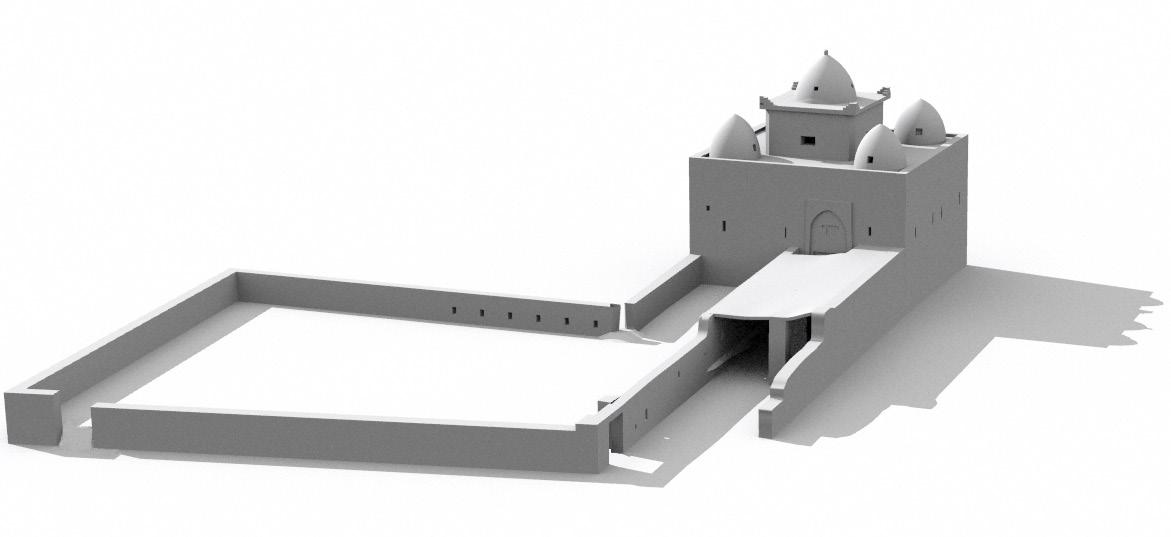
Ksar Ouled Youssef
Three-dimensional view, from south-east, of the Marabout of Sidi Abdellah Khalifa
Exploded axonometric of the Marabout of Sidi Abdellah Khalifa

62 | 63
the
0 1m 2m 5m
Plan of
Marabout of Sidi Abdellah Khalifa

Ksar Ouled Youssef

64 | 65




Ksar Ouled Youssef
View from the rooftop of one of the marabout’s corner domes Bottom-up interior view of the marabout’s central dome
Timber roof of the marabout before restoration
Entrance porch of the Marabout of Sidi Abdellah Khalifa

66 | 67
Arts and Crafts

INTRODUCTION
The craftsmanship of the M’Hamid Oasis, which has been passed on from generation to generation, is an example of the richness of south Morocco’s intangible heritage. Traditionally, men were involved in pottery and metal working. Recently, these activities have not found a generational turnover or artisans have left the oasis, which has resulted in a change in production patterns. Today, with the exception of building, which remains a male activity, all other crafts are the women’s exclusive domain. However, men still partake in the harvesting of palm leaves used by women in various crafts.
The most common female crafts are rug weaving, embroidery and basketry. Women usually craft at home on their own or in small groups of relatives and friends. In recent years a number of women’s cooperatives have been established, and relevant training has been provided in business-related areas to help them make a living out of their crafts. This approach economically empowers and emancipates women, who can contribute to support their families without having to rely entirely on their husbands or sons, while stimulating the local economy and ensuring that the values and knowledge associated with the local arts and crafts are preserved and handed down to the younger generations.
A couple of women’s cooperatives are active in Ksar Talha and Ksar M’Hamid El Ghizlane, while plans for establishing a new cooperative of around 40 women are currently underway in Ksar Ouled Youssef.

and Crafts
Arts
Woman weaving palm fronds into a basket in Ksar Talha

70 | 71
BASKETRY
Baskets are hand woven across southern Morocco by women mainly to transport and store edibles and goods, but also for decorative purposes. In the M’Hamid Oasis, dried palm leaves are the most widely used material. However, canes and reeds, which are increasingly scarce, are used to make small home furnishing items such as lamp shades. Additionally, esparto — a fibre produced by perennial grasses endemic to North Africa and southern Europe — is plaited by men into a strip (called pleita in Spanish) that is used to make farming utensils and harness.
The most ubiquitous palm tree in the oasis is the date palm. Among its numerous species is one that, locally referred to as fagus, is preferred by women for weaving as its longer leaves make plaiting quicker. The most popular basket making technique is the ‘spiral’ (khdmat azaaf), which consists in rolling up the palm leaves in concentric circles around the threads obtained from their own pith, using a needle or stud (lichfa).
Baskets (qafa) and plates (tbaq) of woven dried palm leaves are either left in their natural tone or decorated with colourful inserts made of strands of woollen plastic and foil threads. Following the traditional canons of Berber art forms, these introduce abstract motifs of very bright colours, consisting in elemental geometric forms such as chevrons, triangles, lozenges and chequerboards combined with stylised natural shapes such as leaves.

Handmade decorated baskets and plates
Arts and Crafts

72 | 73
EMBROIDERY
Embroidery decorates household linen, women’s traditional dresses and head coverings. The traditional practice of combing and naturally dyeing yarn with indigo has been discontinued. Nowadays, women purchase balls of yarn in the weekly market.
Black cotton coverings (gnaa) are worn daily by women around their heads and upper bodies with one end typically draped over the left shoulder. The fabric is hand embroidered in woollen yarn in a variety of colours and hues — yellow and orange, red and burgundy, dark and neon green, blue, turquoise and aquamarine, pink, magenta and purple. Motifs are cross and chain stitched using small wooden hoops. Head coverings are decorated with wool tassels, with or without sequins along the edges of the cloth.
The central seam where two pieces of cloth are sewn together is typically finished with a multicolour thread line, off which various geometric motifs branch. This central decorative band, which falls along the women’s spinal column, constitutes the focus of the composition while acting as a symmetry axis relative to which the designs on the sides are skilfully balanced. Embroidered motifs follow the Berber typical ornamental vocabulary of carpets and baskets, which includes straight and curved lines, circles and triangles, combined together in endless variations. Through stylised designs motifs evoke natural objects associated with fertility and prosperity such as trees and flowers.
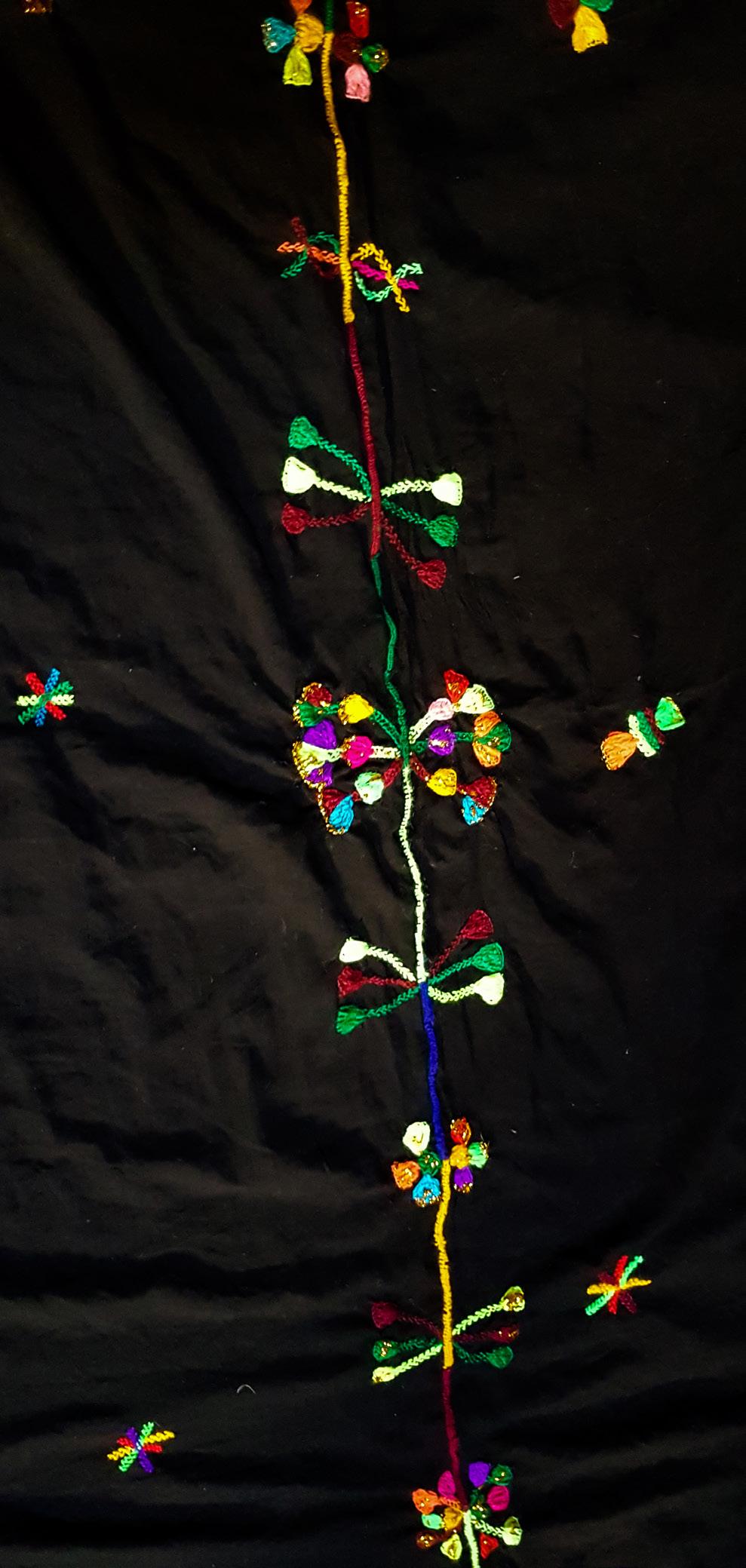
Women’s traditional embroidered black head covering
Arts and Crafts


74 | 75
Machine sewing of embroidered fabric purse
Embroidering of traditional head covering with wooden hoop
CARPET WEAVING AND POTTERY
Two distinct types of carpets are still hand-woven in the traditional way: palm leaf mats and wool or cotton rugs. The former are woven on improvised looms using ropes of the same material as warp, and are laid on the earth floors of houses to insulate as well as sit comfortably and serve food on them. Up until quite recently, floor mats were also made of reed, but this material no longer abounds due to the shortage of water. Plastic mats sold in shops and markets are increasingly common nowadays since they are ready-made, cheap and easy to clean.
Wool or cotton rugs are woven on wooden vertical looms, and used on top of mats, to warm up the rooms where family life and socialising take place. Women weave colourful geometric motifs derived from the triangle. These have been interpreted by scholars as representing a stylised hand (triangle), a mirror or eye (diamond and triangle), sickle, scissors or saw (zigzag pattern), that is all objects that can repel malign forces (jnoun, sing. jinn).
Traditional Berber pottery is manufactured using white or red clay, decorated with incisions or die cuts, and pigmented in black or red, usually by mixing henna, a natural dye extracted from a tree. Pottery work is carried out on manual ground potter’s wheels, as is common in southern Morocco. Currently, there is only one pottery workshop left in the oasis, in Ksar Talha, and is suffering from rapid deterioration due to its disuse.

Arts and Crafts
Traditional Berber loom

76 | 77
Traditional fired white clay jars
MUSIC, DANCE AND ORAL POETRY
Music fills the everyday life of Berber people, enlivening the work in the fields as well as domestic chores. Accompanied by dance it provides a background to the celebration of rites of passage such as birth and infancy, circumcision, courting and marriage, but also work and play, thanksgiving, healing and mysticism The folk music and dance of the M’Hamid Oasis originate from both Berber and Arab traditions and are transmitted orally from father to son. Singing and dancing are performed in groups, often accompanied by drumming and clapping. Voices rhythmically entwine with one another telling stories of a distant past, expressing the visions and values of individuals and groups.
Guedra — the word indicating a cooking pot that turns into a drum when a hide is stretched over — is originally the music and dance of the Tuareg nomads who travelled to the M’Hamid Oasis from the Sahara. It is performed by a kneeling female dancer who, to a heartbeat rhythm, performs movements with her arms and fingers.
Rokba, which in Arabic means ‘knee’, is another traditional music and dance form common throughout the Zagora province. In the oasis it is performed in Ksar Talha, Ksar M’Hamid El Ghizlane and Ksar Ouled Mhia.
Gnawa is a mystical form of hypnotic music combining ritual poetry with singing, dancing and incense burning, and accompanied by drums, metal castanets (lakrakeb) and a bass lute. It is performed in Ksar Bonou.

Arts and Crafts
Songwriter Ibrahim Laghfiri playing the guitar

78 | 79
ROKBA
Performed across the M’Hamid Oasis at weddings, parties, festivities and large community events in the open spaces of the ksour, is a lyrical genre called rokba It is performed by women and men, though more often men only, who sing lined in two parallel facing rows, lifting their knees and stomping their feet in unison. Long chanted interludes narrate stories of the Drawa people, with a focus on the customs and events revolving around the harvest. The lead performer, who stands in the middle of one of the two rows, directs the performance through signs or words that signal changes in rhythm or body movements. The performance is rhythmically accompanied at intervals by the beats of drums, played by kneeling or sitting men positioned at the ends of the rows.
AHIDOUS
Akey
Berber music form incorporating oral poetry is ahidous, which is common across nomadic Berber tribes in central and southern Morocco. It is a collective dance commonly performed at weddings and other celebrations by men and women. Noticeable variations in dance steps, rhythms, song techniques and clothing styles are recorded in ahidous performances amongst different Amazigh groups. As a nomadic cultural heritage ahidous, therefore, is an important indicator of group identity but also a symbolic expression of the crucial role played by women’s fertility in the perpetuation of a particular group’s cultural identity. Facing each other in gender-specific lines and moving at times synchronously at times asynchronously, performers call and respond about life in the desert, love and sorrow, their relationship with nature and God, accompanied by the sound of tambourines.
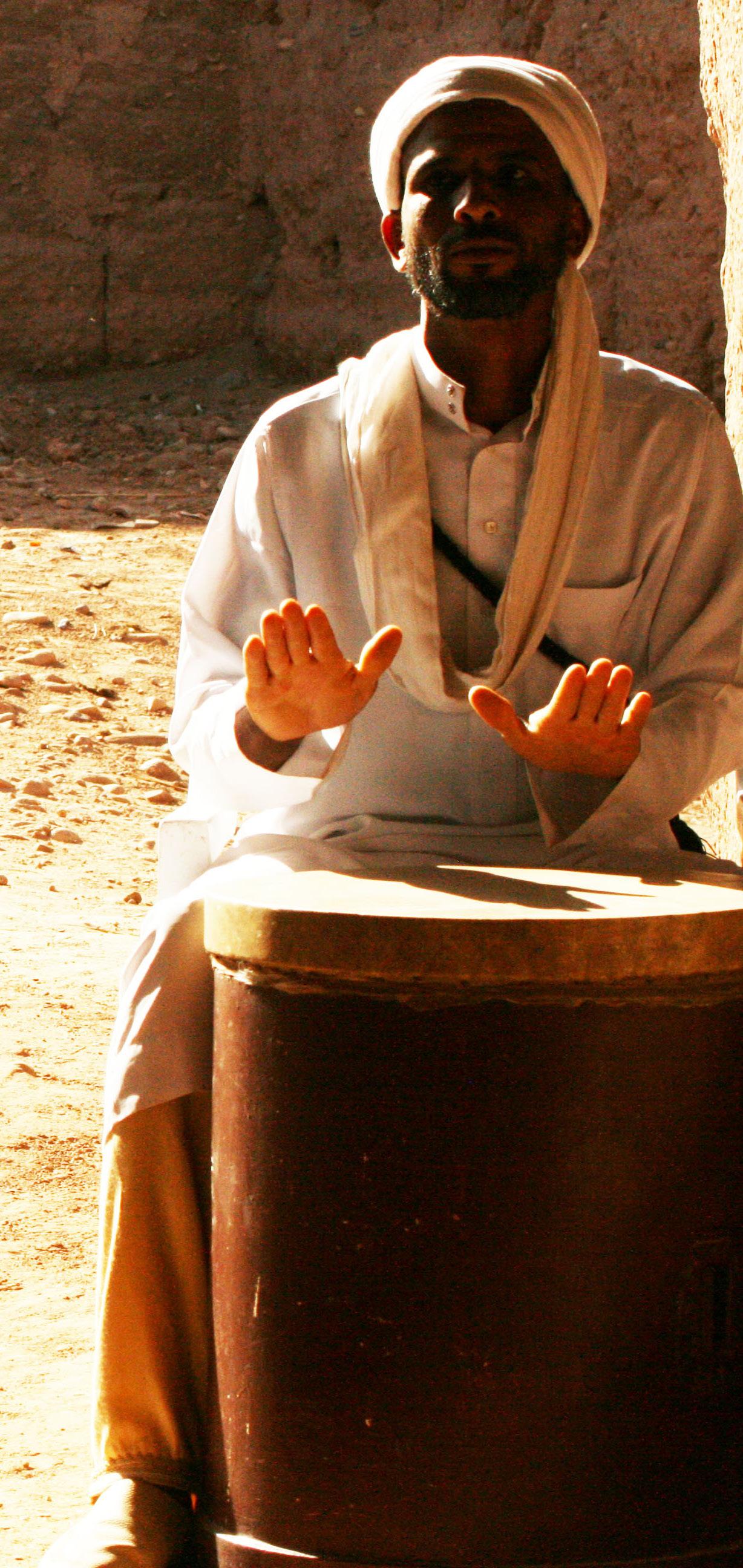
Man playing the drum during Rokba performance
Arts and Crafts
RASMA
Achanted oral poetry tradition common across the Draa Valley and specific to Drawa people is rasma. Poems are composed to be collectively sung during festivities. Often making use of everyday language, they cover a range of subjects and events from people’s everyday life, and are meant to express desires, hopes, joy, faith but also frustrations and sorrow. A rasma group consists of four men: a lead, a co-lead and two performers whose role is to repeat the second half of a line and its end. Women play a self-effacing role, hiding away from the scene but making themselves heard through highpitched notes.

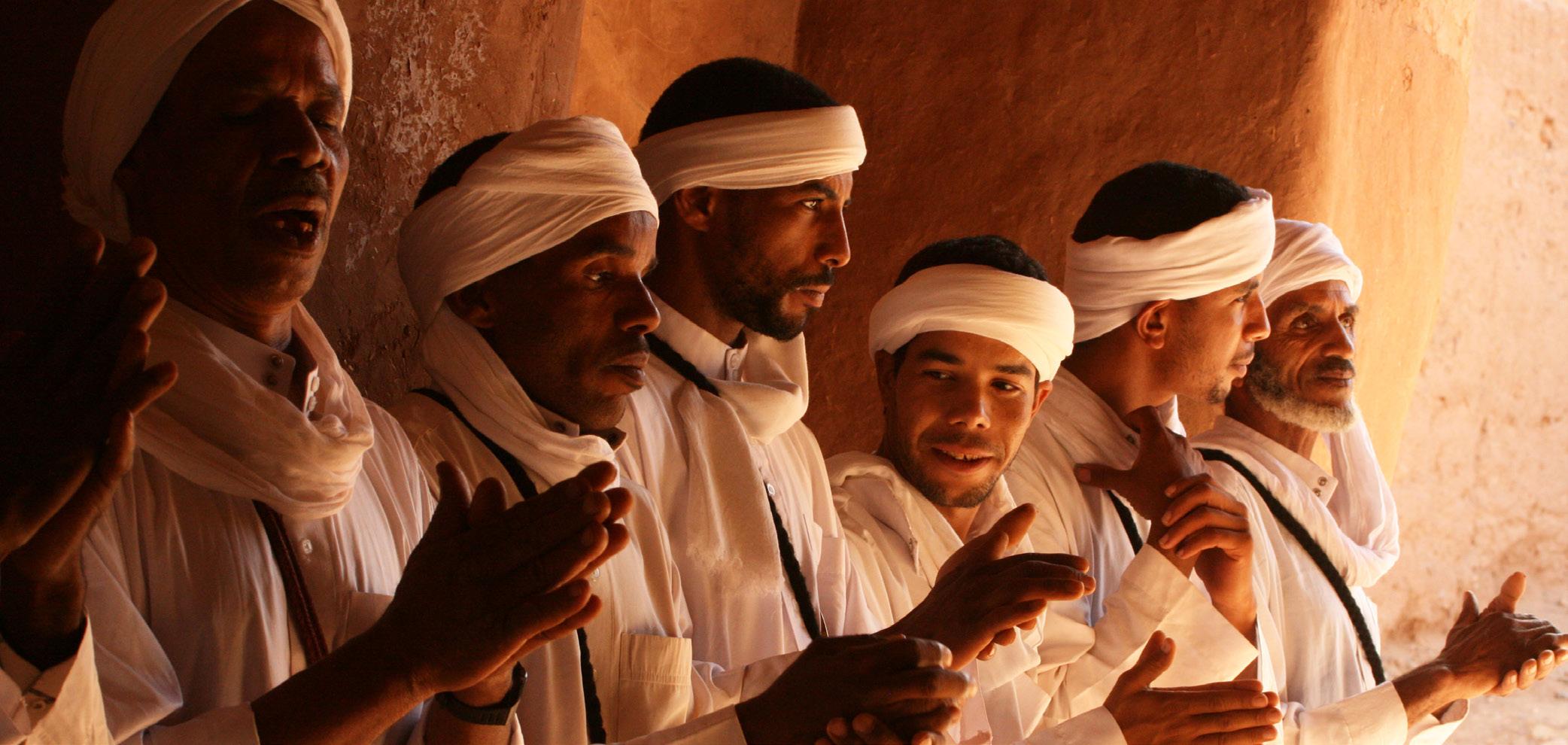
80 | 81
Rokba performers
Rhythmic hands clapping during Rokba performance
GASTRONOMY
TEA
The tea brewing and pouring ritual is a long-standing cultural tradition synonym with hospitality, respect and friendship. Tea accompanies various breaks during the day as well as meals. It is prepared using Chinese gunpowder green tea and adding fresh mint leaves and plenty sugar. It is brewed in metal teapots, letting the water boil for a short while. The spout is initially kept close to the glass rim, then raised up to a metre and arched outwards in a continuous motion, and finally back close to the rim. This is done to aerate the tea and create a froth that suggests that its taste is good.
COUSCOUS
Couscous is the national dish of Morocco, Algeria, Tunisia and Mauritania. In 2020 it obtained UNESCO Intangible Cultural Heritage status. Moroccan couscous is made of tiny steamed balls of semolina, which were traditionally hand-rolled, topped with vegetables (carrots, zucchini, potatoes and turnips) and chickpeas cooked in a mild or spicy stew, and served with meat (mutton, lamb, chicken). It is a symbol of conviviality, epitomised by eating it off a single large plate shared with fellow diners, sitting on the floor.
TAGINE
Tagine is a typical Moroccan dish that takes the name after the glazed terracotta pot in which it is cooked,

Arts and Crafts
Zahra Benchekroun sieving semolina for couscous preparation
consisting of a flat circular base and a cone-shaped lid.
Tagine consists in a slow-cooked stew of thinly cut and marinated meat (mutton, beef or poultry) or fish with seasonal vegetables, to which spices (ginger, cumin, turmeric, cinnamon, saffron), nuts, onion and dried fruits (apricots, prunes) are added.
BREAD
Bread accompanies all Moroccan dishes. Typical bread types include: fat bread (medfouna), also called ‘Berber pizza’, stuffed with a fat-based mix of onion, spices and peppers, and eaten with tea; small flat loaf (khobz) made with wheat flour, yeast and salt; stone bread, baked on small round stones in an earth oven, which is eaten during festivities; and sand bread (mla) baked, by men only, under the sand and hot charcoals.


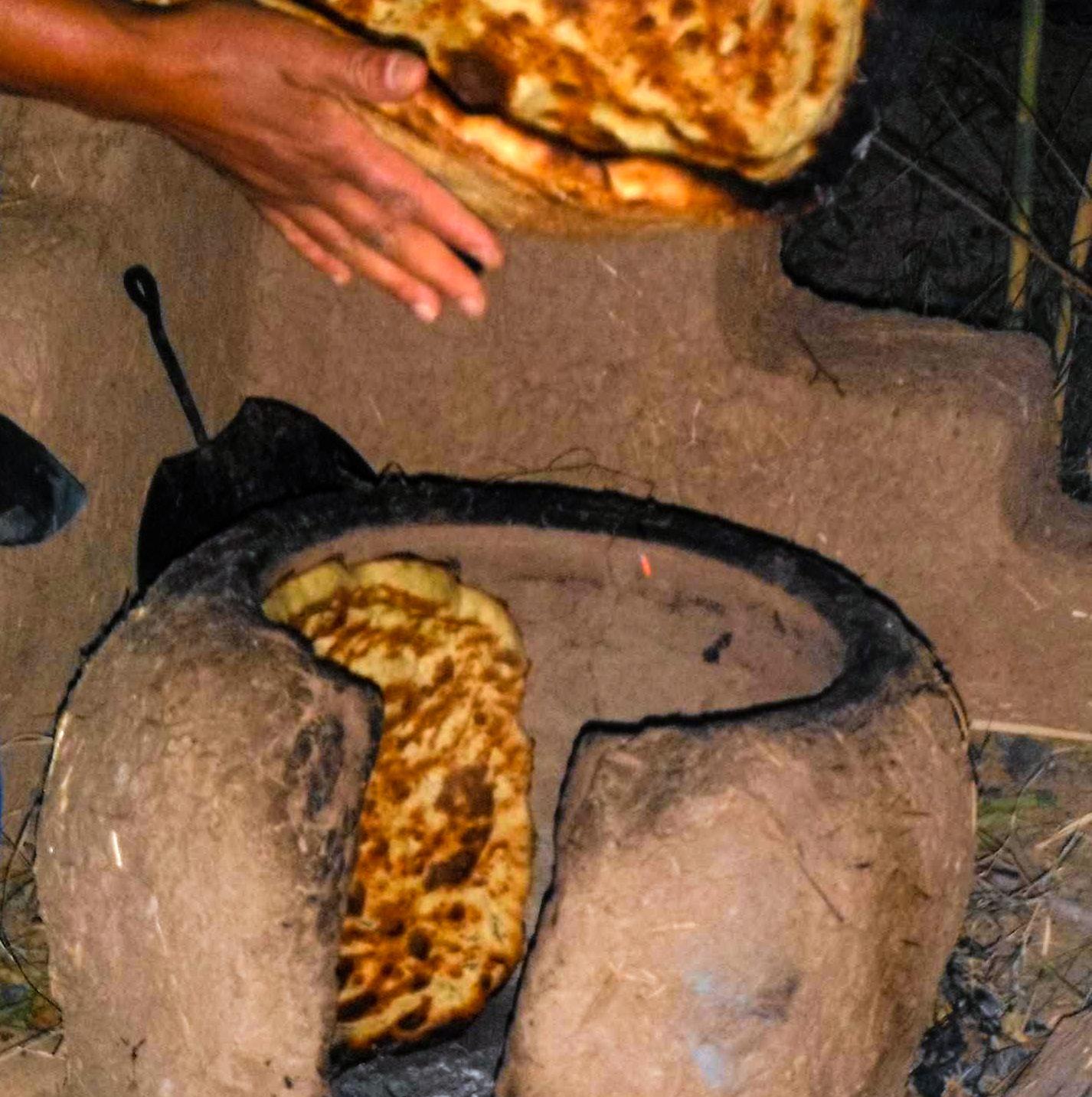
82 | 83
Traditional tea set with serving tray on legs, teapot and glasses
Traditional bread baking on earth oven
Sieved semolina ready to be hand-rolled

and
Arts
Crafts

84 | 85
BUILDING CRAFTS
Earth and architecture have been closely related since the dawn of human civilization. The material’s abundance and the relative simplicity of earthen construction have prompted its use across different climatic regions and historical, economic and socio-political contexts in the world, particularly in areas where wood and stone are scarce. Such is the case with southern Morocco, where traditional architectural and urban forms in oasis settings have been shaped out of factors as diverse as availability of materials and water, defence, protection from the harsh desert climate, relationship with arable land, and have, in turn, shaped the existing natural environment.
In order to understand the distinctive features of earth buildings of southern Morocco and their entanglement with the life ways and life cycles of the individuals and groups that inhabit them, an understanding of the material is essential, for its characteristics define the qualities of the architecture. The monolithic nature of earthen architecture is a direct result of the material’s mechanical characteristics and behaviour. The low mechanical strength of earth materials makes it necessary to build thick walls and large columns. In turn, earthen structures have excellent thermal inertia, which is their ability to store heat and delay its transmission into an interior space, provide good thermal and acoustic insulation and regulate humidity well by constantly absorbing and releasing moisture.
In his prologue to the book Terra Incognita: Discovering

Arts and Crafts
Earth mix used for construction purposes
and Preserving European Earthen Architecture, Henri Van Damme, Scientific Director of IFSTTAR and Professor at ESPCI-Paris Tech, states that ‘Today we know the arrangement of atoms and molecules, but cannot explain how clay slides and rearranges between the potter’s fingers, and hardly begin to understand how sand dunes are formed’ (p. 9). In spite of the apparent simplicity of earth as a material and its application in construction, science has not been able to fully understand the behaviour of this material.
Earth, also referred to as loam when talking about its use in construction, can be defined as any mineral soil containing clay, sand and silt and devoid of organic matter, which, after adding water, can be moulded and left to dry for building purposes. There are nearly as many types of earth as there are soils, but only few of
them are suitable as building materials. In the majority of cases the mix needs to be corrected by adding fine or coarse aggregates, such as gravel or stones, or its quality needs to be improved by including additives.
Variations in water content, texture and additive allow to adjust the mixture to the requirements of each building technique, while taking into account specific local conditions such as seismic or climatic conditions.
These variations may also depend on the local physical, socio-cultural and economic context in which the earth building culture has developed.
The following sections present the earthen building techniques of the M’Hamid Oasis, some of which are widely used throughout the world, while others are unique to Morocco.

86 | 87
Construction of a rammed earth wall
RAMMED EARTH WALLS (PISÉ)
Rammed earth (tallouhat or Iouh), also called pisé in French, consists in the successive compaction, or ramming, of layers of moistened earth inside temporary wooden formworks (tabout). In Morocco these consist of two 245x85 cm side boards (tafraout) made of horizontal wood planks, and two 40-50x85 cm cross boards (tajbat, pl. tajbayn) made of vertical wooden planks. The width of the formwork and the resulting wall thickness can go up to 1 metre in the case of fortress walls.
The most suitable earth for rammed earth construction is obtained from soils of coarser texture, which in some cases include pebbles. After water is added to the earth, this is left to cure for few days before starting building. During compaction, the formwork is held up in place by three pairs of posts (timndat, pl. timdwin). These are tied together by rope at the top and keyed, at the bottom, into cross timbers (chkoul, pl. echkoueln) on which the formwork rests. Once removed, the timbers leave distinctive marks on the surface of the wall. The formwork is dismantled immediately after compaction and reassembled further down, so that the construction of the wall proceeds in horizontal sections.
Generally, rammed earth walls vary depending on the type of wooden ram (markaz) used, the soil composition, the formwork dimensions, and the use of additives, amongst which the most common is lime. Across Morocco, rammed earth construction is fairly standardised, with local variations mainly depending on the formwork dimensions and soil composition.

Arts and Crafts
Rammed earth wall and wooden formwork
MUD BRICKS (ADOBE)
Mud bricks (tob), also called adobe in Spanish, are another earthen masonry technique. Though execution is faster, the tools employed are more complex. Both techniques require expert skills, to build and handle the formworks and rams in the case of rammed earth, and to lay the bricks in the case of adobe. Their use is limited to discreet architectural features such as columns, domes and decorative elements, for which rammed earth is not suitable. In southern Morocco, the traditional mud brick measures 6x12x25.5 cm. Although the dimensions vary greatly, the proportions remain the same. Due to the small size of a brick, the soil must have a high clay content so that the brick does not disaggregate. It is common to add straw to the mix to reduce shrinkage during drying.

ROOFS
Another construction layer requiring high clay content is the top finishing of the roof. In this case very little straw is used, so that the superficial cracks that appear when the mix dries get sealed upon the first raindrops. A crucial aspect in the construction of a roof is to ensure effective drainage of rainwater in order to avoid deep erosion of the top layer. For this reason this has a slight fall that directs the rainwater to the spouts, which are made of tamarisk wood. In M’Hamid, tamarisk is also traditionally used to build the structure of roofs and floors, since it is more resistant and durable than palm wood. However, tamarisk branches are smaller, shorter and more irregular in section, which limits the size of interior spaces.

88 | 89
Mud bricks laid on the ground to dry in the sun
Roof construction with tamarisk branches and reed mats
PLASTERING AND TADELAKT
Earthen construction is extremely vulnerable to water erosion, which makes the rendering of walls crucial. The mix used in mud renders is rich in clay, and it is imperative to add straw to it in order to avoid excessive cracking, which would expose the masonry to water infiltration. On the other hand, the mix used in plasters is richer in sand and contains less straw, which makes the plaster more durable.
In some areas of the Atlas region it is common to find shallow eaves made of reed and mud mortar at the top of walls. In contrast, in M’Hamid, where rainfall is rather scarce, the walls have no other protection than the rendering. Regular maintenance on earthen surfaces is, therefore, necessary every few years in order to prolong the life of the building.
Tadelakt is a Moroccan traditional water-resistant lime plaster. It is originally from an area of the lower Atlas, near Marrakech, where limestone is still quarried. Both the technique and the material are called tadelakt, which means ‘to rub in’ in Berber. The mix comprises lime, in some cases marble or limestone sand, and natural soap, usually black or olive oil soap, which makes it water-resistant. After being applied, it is compressed with a flat river stone, smoothed and polished with finegrained sandpaper, a plastic sheet and a river stone, and finally sealed with an olive-oil soap solution. The material can have either a shiny or matt finish. Tadelakt is the traditional coating of interior walls, often ceilings and floors, of palaces, hammams and bathrooms in the traditional houses (riads) of Moroccan cities’ historic cores (medinas). Since it is water-resistant it is also used to coat hand-crafted terracotta household items such as water vessels and food containers.

Arts and Crafts
Master Abdelkader Mahassine rendering the marabout’s dome

90 | 91
GLOSSARY
Amazigh, pl. Imazighen: adjective meaning ‘Berber’ in Berber language.
Castrum: building or plot of land used as a fortified military camp in the Roman Empire.
Chkoul, pl. echkoueln: cross timbers into which the timdwin are keyed, and on which the rammed earth formwork rests.
Chorfa: tribe thought to be descendants of the Prophet Muhammad.
Coucha: domestic earth oven.
Dar (or tiguemmi in Berber): house.
Drawa, sing. Drawi: original settlers of the Draa Valley.
Fagus: palm tree species with longer fronds used for weaving purposes.
Gnaa: hand-embroidered black cotton covering worn daily by women around their heads and upper bodies, with one end typically draped over the left shoulder.
Gnawa: mystical form of hypnotic music combining ritual poetry with singing, dancing and incense burning, and accompanied by drums, metal castanets and a bass lute.
Guedra: music and dance performed by a kneeling female dancer who, to a heartbeat rhythm, performs
movements with her arms and fingers.
Hammam: building or room for public baths.
Henna: yellowish-red powder obtained from dried privet leaves and used as dye, mainly for temporary body art.
Jinn, pl. jnoun: supernatural spirits that prey on people going through key transitions in their life.
Kasba (or tighremt in Berber): type of fortress built by a local chieftain, usually a qaid, to live in with his family.
Khobz: small round flat loaf made with wheat flour, yeast and salt.
Ksar, pl. ksour (or ighrem/aghrem, pl. igherman in Berber): a defensive fortified village containing houses and public spaces, such as mosques, open spaces and baths.
Lakrakeb: metal castanets used in traditional music.
Lichfa: stud used in basket making to weave the palm leaves together.
Louh: see tallouhat.
Maalem, pl. ma’lmin: master builder, master craftsman.
Marabout: funerary building where a Sufi Muslim religious leader and teacher is buried.
Markaz: wooden ram used to compact the earth inside
the formwork.
Medfouna: large round and flat loaf filled with a fatbased mix of onion, spices and peppers.
Medina: historic part of an Islamic town or city, typically walled, with a dense built fabric and a maze-like network of narrow and winding streets and alleyways.
Mihrab: prayer niche in the qibla wall of the mosque that indicates the direction which should be faced when praying.
Mla: round flat bread baked under the sand and hot charcoals.
Pith: soft fibre filling the inside of the palm tree trunk.
Pleita: belt or strip made of plaited esparto fibres, which is sewn to others to make mats, saddlebags and other crafts items.
Qafa: hand-woven basket.
Qaid: judge or governor.
Qaidat: home of a qaid.
Qibla: wall in the mosque that indicates the direction towards the Kaaba in Mecca.
Rasma: chanted oral poetry tradition performed by a group of four men during festivities, and accompanied by women’s high pitched notes.
Riad: traditional urban mansion typical of Moroccan medinas, on two or more storeys organised around a central courtyard with a fountain.
Rokba: music and dance with chanted interludes, generally performed in rows by men and accompanied
by drumming and hands clapping.
Seguia: oasis irrigation system comprising small dams, bridges, dikes and channels.
Shaduf: traditional balance beam well.
Spiral (or khdmat azaaf in Arabic): basket-making technique that consists in rolling up the palm leaves around the threads obtained from their own pith.
Suq: weekly market.
Tabout: wooden formwork used to build rammed earth walls.
Tadelakt: lime-based waterproof plaster.
Tafraout: side boards of a tabout.
Tajbat, pl. tajbayn: cross boards of a tabout.
Tallouhat: rammed earth construction (pisé in French), obtained through successive ramming of layers of moistened earth inside temporary wooden formworks.
Tamazight: the native language of Berbers.
Tbaq: hand-woven plate.
Timndat, pl. timdwin: wooden posts that hold up the tafraout in place.
Tob: brick made from mud mixed with straw, moulded by hand and sun-dried (adobe in Spanish).
Wust-ed-dar: courtyard of the house.
Zawiya: Islamic religious school or monastery.
92 | 93
“Ahidous.” Available at https://www.draaheritage.org/ ahidous/ [Accessed 18 September 2020].
Almakari, Ahmed, et al. Trésors et Merveilles de la Vallée du Drâa. Editions Marsam, 2004.
Barbour, Nevill. A Survey of North West Africa (The Maghrib). Oxford University Press, 1959.
Becker, Cynthia J. Amazigh Arts in Morocco: Women Shaping Berber Identity. University of Texas Press, 2006.
Colmenares, Marta, et al. M’hamid, la dernière oasis du Drâa. Mairea Libros, 2016.
Curtis, William J. R. “Type and Variation: Berber Collective Dwellings of the Northwestern Sahara.” Muqarnas, vol. 1, 1983, pp. 181-209.
Dłużewski, Maciej. “Reasons for Development of the Dune Fields in the Coude du Dra Region.” Contemporary evolution of the natural environment of the region between Antiatlas and Sahara (Morocco), edited by Stefan Skiba and Kazimierz Krzemień, Instytut Geografii i Gospodarki Przestrzennej, 2008, pp. 51-63.
Domínguez Martínez, Oriol, and Alejandro García Hermida. “Learning from Tradition. The Experience of Terrachidia in the South of Morocco.” Architecture in the Age of Austerity, edited by Alejandro García Hermida et al, Mairea Libros, 2013, pp. 61-64.
Jacques-Meunie, Denise. Le Maroc Saharien, Des Origines a 1670. Hors Collection Klincksieck, 1982.
Hensens, Jean. Qsours et Qasbas du Maroc. Réflexions sur l’Evolution de l’Habitat Rural Traditionnel. Marka Print Pte Ltd, 1986.
“Kasba.” Encyclopédie berbère, 27 | 2005, document K29. Available at http://journals.openedition.org/ encyclopedieberbere/1318 [Accessed 15 September 2020].
“Ksar.” Encyclopédie berbère, 28-29 | 2008, document K74. Available at http://journals.openedition.org/ encyclopedieberbere/127 [Accessed 15 September 2020].
Karmaoui, Ahmed, et al. “Analysis of the Water SupplyDemand Relationship in the Middle Draa Valley, Morocco, under Climate Change and Socio-economic Scenarios.” Journal of Scientific Research & Reports, vol. 4, no. 4, 2016, pp. 1-10.
Landau, Rom. The Kasbas of Southern Morocco. Faber and Faber Ltd, 1969.
Le Quellec, Jean-Loïc, et al. Maisons du Sahara. Habiter le désert. Hazan, 2006.
Mattingly, David J., and Martin Sterry. “Introduction to the Themes of Sedentarisation, Urbanisation and State Formation in the Ancient Sahara and Beyond.” Urbanisation and State Formation in the Ancient Sahara
BIBLIOGRAPHY
and Beyond, edited by Martin Sterry and David J. Mattingly, Cambridge University Press, 2020, pp. 3-50.
Mimó, Roger. Fortalezas de barro en el sur de Marruecos. Compañía Literaria, 1996.
Naji, Salima. Art et Architectures Berbères du Maroc. Édisud/Eddif, 2001.
Nijst, A. L. M. T., et al. Living on the Edge of the Sahara: A Study of Traditional Forms of Habitation and Types of Settlement in Morocco. Government Publishing Office, 1973.
“Rokba.” Available at https://www.draaheritage.org/ rokba/ [Accessed 18 September 2020].
Rabaté, Marie-Rose, and Frieda Sorber. Berber Costumes of Morocco: Traditional Patterns. ACR, 2007.
Soriano Alfaro, Vicent. Arquitectura de Tierra en el Sur de Marruecos: el Oasis de Skoura. Fundación Caja de Arquitectos, 2006.
Terrasse, Henri. Kasbas Berbères. De l’Atlas et des oasis. Le grandes architectures de Sud marocain. Actes Sud/CJB, 2010.
Vogelsang-Eastwood, Gillian, and Caroline Stone.
“Embroidery from Morocco.” Encyclopedia of Embroidery from the Arab World, edited by Gillian VogelsangEastwood, Bloomsbury Academic, 2016, pp. 188-209.
Zerhouni, Selma, and Hubert Guillaud. L’Architecture de Terre au Maroc. ACR Édition Internationale, 2001.
94 | 95






Old
in the
Ouled Youssef A rCHIAM
An
Ksar
M’Hamid Oasis
& Terrachidia

























































































































